#not the two most famous shows for historical accuracy
Explore tagged Tumblr posts
Text
I wanted to post bitching about the stupid tv series set decisions, where witchy room always have the random dried stuff hanging everywhere always (Gaius has them, OUAT had them the last episode whoch got me like uhhhh)
but then I realized I have a big-ass amount of Alkekengi officinarum branches hanging in my room exactly the same way

(I still mantain it's a cheap set decision and absolutely random, but you know what... I guess them magical and medieval sciency peeps need these dried random stuff XDDD)
#if it works it works#sweet irony#I do not always have stuff hanging up to dry#they were a gift from my neighbours so I can plant them next year <3<3<3<3#moss text#to be fair in ouat s05 the sets are.........#let's just say the random stuff in the witch hut was the last of the problems#Gaius' chambers are beloved but still they just went: he has weird stuff let's cram random shit all over the place#XD#then again#not the two most famous shows for historical accuracy#non solo le cazzo di rose rosa anche le cazzo di rose gialle a muzzo in scozia#anyway#goodnight#if you have branches hanging to dry welcome to the club
4 notes
·
View notes
Text

TWO HOLOCAUST REMEMBRANCE DAYS
There are two main Holocaust remembrance days:
Yom HaShoah, the Jewish Holocaust remembrance day, was first commemorated in 1951. It is observed on the 27th of the Hebrew month of Nisan and falls on the anniversary of the Warsaw Ghetto Uprising.
International Holocaust Remembrance Day was not established by the international community until 2005 and falls on January 27, on the anniversary of the Soviet liberation of Auschwitz-Birkenau.
These two separate commemoration days are emblematic of two very different approaches to Holocaust education: one which centers the experience of the primary victims of the Holocaust -- Jews -- and another which instead highlights the supposed saviors of the Jews.
HAS HOLOCAUST EDUCATION FAILED?
Holocaust denial, revisionism, inversion, and distortion are widespread today.
Recent surveys show deeply disturbing trends among Gen-Z; for example, a 2020 comprehensive survey by the Claims Conference found that 36% of respondents believe “less than 2 million” Jews were murdered in the Holocaust. In New York state, nearly 20% of millennials and Gen-Z believe that Jews caused the Holocaust.
Likewise, in 2023, the Claims Conference found that 23% of Dutch millennials and Gen-Z believe the Holocaust is a “myth” or “exaggerated.”
According to the latest Anti-Defamation League Global 100 survey of worldwide antisemitism (published in January of 2025), only 48% of people worldwide “recognize the Holocaust’s historical accuracy.” Among the 18-34-year-old demographic, the findings are even worse: only 39% recognize the historical accuracy of the Holocaust.
In the United States, most states do not have mandatory Holocaust education, but even when they do, there exists no standardized curriculum, which means the mandatory education often falls short.
THE PROBLEM
In the first few decades after the Holocaust, there was little interest in the Holocaust. Immediately following liberation, the world responded with shock and horror to the grotesque imagery coming out of the Nazi death camps. But then they moved on quickly, preoccupied by the Cold War and other issues.
Meanwhile, many Jewish Holocaust survivors were afraid to center -- or even talk about -- their experiences. There was great stigma and shame associated with being a Holocaust survivor, including in Israel. Many Israelis resented Holocaust survivors, (incorrectly) believing that the only way they could have possibly survived the Nazi genocide would be if they had collaborated with the Nazis (for example, as Kapos). Others (also incorrectly) resented the Jews in Europe for “not fighting back”). In Israel, this attitude only started to change after the 1961 Adolf Eichmann trial, when survivors spoke publicly of their experiences for the first time when they took the stand.
Some survivors, like famous Nazi-Hunter Simon Wiesenthal, felt that Jews should de-emphasize the intentionally antisemitic nature of the Holocaust in order to get the non-Jewish world to care. In fact, you might’ve heard that 11 million people — 6 million Jews and 5 million others — perished in the Holocaust. This is a fake figure. Frustrated by the non-Jewish world’s lack of interest in the Holocaust, Wiesenthal created a figure to de-emphasize its anti-Jewish nature, knowing that the world would likely be more interested in the plight of others. Historians who knew him say that he chose the figure carefully: 5 million was a large number, but not a number large enough to obscure the 6 million Jewish victims.
NOW, HOLOCAUST EDUCATION OFTEN UNIVERSALIZES THE HOLOCAUST
The Holocaust was the industrialized slaughter of 6 million Jews and over one million Roma and Sinti by the Nazis and their collaborators. While the Nazis targeted many groups, only Jews — and in some countries, Roma — were subject to extermination as per the policies of the Final Solution. The Holocaust destroyed 66 percent of Europe’s Jewish population over the span of less than six years.
Holocaust universalization is the tendency to treat the Holocaust as “public property,” stripping Jews of their unique experience. Instead, the Holocaust is treated as a tragedy that befell onto mankind, rather than a genocide that specifically and intentionally targeted Jews.
According to Holocaust historian Dr. Elana Heidenman, Holocaust universalization turns the Holocaust into “a joke, a mere moment in history that is no longer relevant unless through an exaggerated comparison, [and] terms of reference that have lost all depth and all substance.”
The universalization of the Holocaust erases Jews’ “right” to the memory and understanding of the Holocaust. The world largely treats the Holocaust as a “lesson to be learned,” rather than a genocide that decimated the Jewish community. How many people who invoke the Holocaust actually care about the plight of Holocaust survivors today? How many people who invoke the Holocaust are committed to unlearning their own antisemitic biases? Holocaust universalization almost inevitably always distorts basic facts about the Holocaust. It’s worth noting that Holocaust distortion is a form of Holocaust denial.
WHAT MAKES FOR EFFECTIVE HOLOCAUST EDUCATION?
(1) Effective Holocaust education must center the victims of the Holocaust. Beware of overemphasizing the experiences of saviors over the experiences of victims and survivors.
After all, arguably, for Jews, the most enduring memory of the Holocaust is that the world failed us: not just the Nazis and their collaborators, but international institutions like the Red Cross and the Vatican, our own neighbors and friends, the non-Jewish anti-Nazi resistance, and even the Allies, who ignored the urgency of our plight until it was too late.
(2) Effective Holocaust education must provide specificity and context; it’s important for students to understand the specific historic and social conditions that allowed the Holocaust to happen. Most notably, students cannot adequately comprehend the Holocaust if they do not learn about the 2000 years of systemic European antisemitism that preceded it.
(3) Beware of universalizing the Holocaust. While it’s true that he Holocaust can teach us many valuable universal lessons about issues such as intolerance, fascism, and bigotry, it shouldn’t be taught only as a moral lesson for humanity; instead, students should also learn the lesson of the dangers of unfettered antisemitism.
(4) Effective Holocaust education must prioritize primary sources over fictional accounts.
UNDERSTANDING THE CONDITIONS THAT MADE THE HOLOCAUST POSSIBLE
In order for Holocaust education to be effective, it must always strongly emphasize the antisemitism that led to the Holocaust.
You cannot divorce the Holocaust from the antisemitism that caused it. The Nazis persecuted Jews specifically based on antisemitic tropes and conspiracies that have been ingrained into the DNA of our societal institutions. The Holocaust wouldn’t have been possible without the 2000 years of antisemitism that preceded it.
The Holocaust was possible because the Nazis animated the previously-existing and sometimes dormant antisemitism of German society and the societies of the countries they conquered. There’s a reason many of the worst massacres during the Holocaust were perpetrated not by the Nazis, but by collaborators. The Jedwabne pogrom comes to mind. There’s a reason the institutions that were supposed to protect human beings — ahem, the Red Cross — chose to look away at best and collaborate at worst.
Again: without antisemitism, there wouldn’t have been a Holocaust. It’s imperative for Holocaust education to emphasize this point.
"NEVER AGAIN" MEANS UNDERSTANDING THAT THE END OF THE WAR DID NOT END ANTISEMITISM
Antisemitism did not end with World War II. In fact, after liberation, thousands of Jewish survivors were robbed and even murdered by their former neighbors in Eastern Europe when they attempted to reclaim their old homes. The first post-Holocaust pogrom was the Krakow pogrom, which took place in August of 1945. After that, pogroms spread to 11 other Polish cities.
The most infamous of these pogroms is the Kielce pogrom in 1946, when 42 Jewish refugees were murdered by a mob of Polish civilians following a blood libel. The refugees were horrifically beaten, shot, and even thrown out windows. A survivor of both the Holocaust and the Kielce pogrom later testified, “I would like to mention that as a former prisoner of concentration camps I have not gone through an experience like this. I have seen very little sadism and bestiality of this scale.”
Holocaust education that does not teach students to identify the persisting antisemitism in the world does an injustice to Holocaust victims, survivors, and the promise of “Never Again.” This includes recognizing how ancient antisemitic tropes, stereotypes, and conspiracies manifest today.
For a full bibliography of my sources, please head over to my Instagram and Patreon.
rootsmetals
“I thought in 1945 antisemitism died in Auschwitz, but I was wrong. Its victims perished, antisemitism did not.” — Holocaust survivor Elie Wiesel
113 notes
·
View notes
Text
There's definitely a conversation to be had about the presentation of real historical figures in historical fiction, I think. As both a professional historian (PhD student 🤘🏾😔) and a man of color, I'm a bit more sensitive to this than a lot of people, and for me it always comes down to the question - what real harm is being done here?
And that's where I think OFMD does well enough for me to be comfortable. If you look at the fact that the show is based on real-life terrible people who did awful things and participated in the slave trade and you don't wanna fuck with the show, that's completely understandable, but I find it so much more palatable than (for the easy comparison) a piece of media like Black Sails (I actually like Black Sails, believe it or not, but there are a lot of things about how it treats many of these same figures that make me uncomfortable).
Now, yes, OFMD is hand-wavey with the slave trade in the Caribbean. None of our main characters own slaves or directly reference the slave trade (again, this is a romcom, I'd be shocked if they did). For me, this works alright for two big reasons. First, there are things that I think you can include in a romcom and have it still be a romcom, and a thoughtful, respectful depiction of the slave trade would take the show firmly out of romcom territory. Second, the show doesn't pretend racism doesn't exist, it treats its characters of color as three-dimensional people, and we always get the last laugh when racism is depicted. The very first episode sets the scene by having racist English Navy officers demean and call a Black character "slave" and they immediately get their asses kicked for it. Compare this to a show like Black Sails, where one of my main criticisms is how we're expected to sympathize with characters who actively participate in the slave trade and own slaves.
My other thing here is the people OFMD is working with are both heavily mythologized and not treated with any degree of historical accuracy. Many of our characters who are famous pirate names you might know are nothing like their real-world counterparts (take pirate queen Zheng Yi Sao, who wasn't even born yet when the show takes place). We know so little about any of the real people, anyway, that OFMD doesn't even bother trying to get anything right.
Like I said, I'm a professional historian and I love working with the golden age of piracy. That's a big reason I was drawn to this show in the first place! And if there's one thing I know, it's that pirates have been made into legends. We know very little about the real people, and in pop culture they're just myths.
The characters in OFMD are basically fictional characters working with the loose mythology based around the real people.
Now, back to my big thesis here: are the real, awful people benefitting in any way from OFMD taking these characters and making them into the good guys? Realistically, no, I'd argue. Most people with any critical thinking skills know that real pirates were not good people. Many people think Blackbeard is a made-up generic pirate character as it is. I've been to the real-life Stede Bonnet's grave site (NOT for the show, this was years before it aired and I was visiting the archives there to see the trial documents for a research project), and the historic marker there says he was "brought to justice." No one is wataching this show and thinking "oh those real guys must have been pretty great dudes!" because it's not about those real people.
This show isn't trying to change your perception of the real people, it's showing you fictional characters with the same names. One of our characters is runnig around in crocs, this show isn't trying to teach you about history or the real people and it's obvious.
If you're put off by the premise, I get it! But I just don't buy the idea that OFMD is putting anything harmful into the world just by existing.
531 notes
·
View notes
Text
There are honestly so many fundamental things about Ridley Scott's Napoleon I disliked, I hardly know where to start so here's just a couple things that popped into my head. All of the disappointed/angry reviews I saw really were on the money with their criticisms. Below the cut a bunch of things in no particular order
Apart from the scenes in Egypt and Elba (which are sepia-tinted) the entire movie is colorgraded with a blue-grey tone like the most painfully dreary wet day in late autumn. Just watching it I got hypothermia. Just take these two shots - the first from the 1970 waterloo movie (highly recommended, can be found for free on youtube), the second from 2023 - to see the difference.
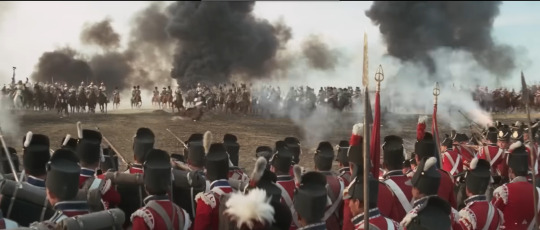
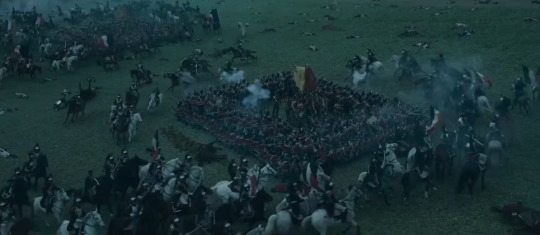
Despite a massive budget and cgi available the battles actually felt incredibly small. The Waterloo scene in particular felt like it was taking place on a patch of grass that was a 100 meters square, with two thin lines of French infantry advancing towards a relatively small group of British infantry dispersed within a couple meters of trenches, with the tents of their camp only meters directly behind that. It gave the entire thing the sense like it was a large reenactment society of maybe 200 people giving it their all, rather than 140.000. The 1970 Waterloo might be 50 years old but showed vastly, vastly more impressive scenes of huge formations of men, offering awe-inspiring cinematography compared to Scott's tiny Waterloo skirmish. I'm perfectly willing to accept disgustingly bad historical accuracy as long as the pictures are sufficiently pretty. They were not.
As a note, in the movie the British infantry inexplicably decides to walk forwards out of their fortified trenchline on the slope (complete with spikes) and form squares in front of it, instead of simply staying inside of their trenches.
There's a fucking sniper at Waterloo. Like, an infantryman with a rifle with a scope on it. He blows a golfball-sized hole in Napoleon's hat.
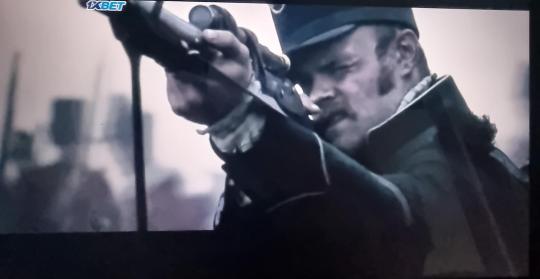
The Marshals - each colorful, fascinating characters many of whom would individually be worthy of their own movie - are less than background characters; I don't think any were even mentioned by name, and there's only two or three that are regularly seen on screen. Marshal Ney, famous, brave, tragic Ney, who has a very distinctive redhead appearance, was rendered completely unrecognizable by adding a moustache.
Phoenix's Napoleon has no charismatic presence whatsoever. Anyone who wasn't already reasonably familiar with Napoleon before seeing this movie would be dumbfounded why so many people followed him at all, or why upon his return from Elba thousands of soldiers sent to stop him simply deserted to his cause as soon as he approached. If you want to create a movie to deconstruct Napoleon from a brilliant national hero to a flawed man there are infinite ways to do so, and they chose the most sub-par by just making him kinda odd and insecure.
Napoleon's military genius is underexplored if not entirely absent from the movie, and to a large extent it simply feels like events are just kinda happening to him, especially with the way short disparate scenes are quickly strung together. One second we're in the aftermath of Austerlitz (1805), and two or three 1-minute scenes we're at the invasion of Russia (1812). Some of Napoleon's finest moments as a general are omitted from the film such as the Italian campaign, Jena-Auerstedt, and the six-day campaign of 1814 where Napoleon so thoroughly outgeneralled his opponent his tiny 30K man army inflicted nearly 30K casualties on enemy forces twice his size over the course of four battles.
Meanwhile his crowning achievement at Austerlitz is reduced to yelling thrice for hidden units to attack and then the entire enemy army flees onto an ice lake fit for a fantasy movie (just check out the ice scene from the 2004 King Arthur) and gets sunk by cannon fire. If you've seen the trailer you've seen almost the entire battle.
Huge parts of the movie are devoted to his marriage to Josephine, which I personally don't find terribly interesting to begin with, and historical events are contorted to be related to his marriage (such as ditching his army in Egypt because she's cheating on him), but it often felt to me like this storyline, such as it was, was firing in certain directions only to abruptly cut them off or let them go nowhere, and the movie seemed unsure whether it was the A-plot or the B-plot or a secret third thing.
Before I forget... not once but twice Napoleon is charging into the thick of the melee on horseback!!! First where he is at the very front of a cavalry charge at Borodino (the 30 seconds of it that we got, which were all in the trailer) and second near the end of Waterloo before making a run for it. And it's so patently absurd! It's like a WW1 movie with Kaiser Wilhelm personally storming the trenches or Emperor Hirohito flying a plane at Pearl Harbor. Napoleon demonstrated plenty of bravery in his life (such as when he was wounded by a bayonet at Toulon, or attempted to lead a charge at the bridge at Arcole) but the Emperor of the French was not at the fucking forefront of a massed cavalry charge with sabre in hand scything down infantrymen.
The movie ends with a card with casualtyfigures from a bunch of battles as if it's a sobering statement at the end of a Holocaust movie, so the Brits can remind you Napoleon was actually Hitler.
#napoleon movie#I've seen bad movies in my life but I've never been so disappointed by one#I wanted it to be good. And it was the opposite.
15 notes
·
View notes
Text
Family Registries (Final Effect)
Many families, especially the Heroic Houses, maintain Family Registries. These registries record every single birth, death, and marriage associated with the family. Any child born to the family is recorded, and their parentage noted. Traditionally, their significant deeds and accomplishments.
One of the reasons that such registries are maintained is because Semblances and other Aura characteristics are at least partially hereditary although they often change slightly from one generation to the next. It is therefore possible to predict someone’s possible Aura characteristics and Semblance based on their heritage. This can be vitally important when it comes to powerful Semblances or those that have unique properties (e.g., Creation of All Things).
Lineage is also vitally important for inheritance purposes. The Heroic Houses have substantial holdings, so knowing who inherits what is critical. The Heroic Houses also have funds and other sources of income that are used to help their members with things like education and so forth. Again, being able to prove that someone is from that family is key to them gaining access to those resources.
Family Registries are also a matter of pride and historical importance. The people of Remnant place great stock in the achievements of their ancestors and take great pride in the deeds their predecessors have accomplished. Many people enjoy being able to prove that they are descended from someone who has done great things, and there is a strong desire to see their own deeds acknowledged on such registries.
At present, the House of Farron-Arendelle maintains the most complete Family Registry. It is managed by the Dia-Farron who have painstakingly kept track of all members of the House’s various branches (basically the Lightning, Serah, and Lumina branches since all members of the House can trace their descent to one of the three sisters). They also maintain Family Registries for certain other families and their beloved hamsters.
One of the greatest punishments that can be levied against someone from a Heroic House is to be stricken from their Family Registry. This is a denial and rebuke of their evil deeds and also of their very existence. Such a person is to be reviled for all time, their very name a curse and an insult. On the flip side are those who are adopted and added to the Family Registry. This is a show of love and affection, a statement not only to the present but also all those who will come in the future that a certain person is a member of the family, regardless of their bloodline or lineage. Adopting someone into the Family Registry is usually a reason to celebrate, for another has been found who belong with the family.
This is why people like Coal can become centres of controversy. He is a direct descendant of a member of the House of Sato. He should be on their registry. That he was not speaks poorly of the House since either they did not have systems in place to record his birth or his parents chose to conceal it (which would be far worse). That Galatea offers to formally adopt him comes with the offer of adding him to the Family Registry of the House of Farron-Arendelle, specifically, the Dia-Farron Branch of the House.
That was a big deal because it involved a dispute between two Heroic Houses that can trace their roots back to the Age of Heroes.
For smaller and less famous families, the Dia-Farron have made software available that makes creating a Family Registry relatively easy although the contents of the registry must be verified by independent observers to ensure its accuracy. It is customary that orphans whose ancestry cannot be traced are given this software for free along with a blessing that basically goes along the lines of “Start your own family, and made your deeds and theirs be worthy of remembrance in this registry”.
4 notes
·
View notes
Text
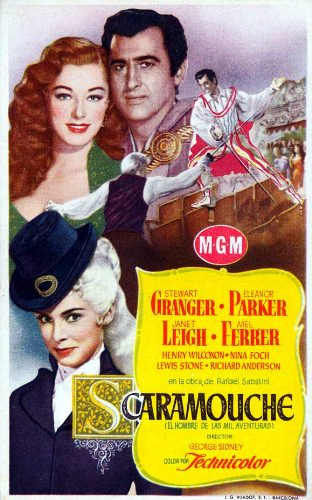
Day 41- Film: Scaramouche
Release date: June 27th, 1952.
Studio: MGM
Genre: Action/Adventure
Director: George Sidney
Producer: Carey Wilson
Actors: Stewart Granger, Eleanor Parker, Janet Leigh, Mel Ferrer
Plot Summary: We follow the adventures of Andre Moreau in pre-revolutionary France as he searches out his biological father, runs from the law with revolutionary friend Phileppe, tries to avenge Phileppe’s death at the hands of the Marquis de Maynes, hides out as famous comedian Scaramouch, and woos two different women.
My Rating (out of five stars): ***½
It took me awhile to really get into this movie, but once I did, I enjoyed it. It was the kind of light-hearted colorful historical epic you would expect from 1950s Hollywood. Flashy and splashy but not overly complex in terms of character or nuance. And certainly not overly concerned with historical accuracy! Some spoilers ahead.
The Good:
The fencing! The fencing! If there is one thing that elevates this film and makes it worth checking out, it’s the sword fighting. There’s lots of it, and it is all convincing and well-staged. (Except for the speed at which blood spurts out of people when they get slashed!) The actors all did pretty extensive training to learn how to make it realistic, and it shows. The sword fight at the end of the movie is the longest in Hollywood history, as far as I know.
This kind of goes with the above, but I absolutely loved the fact that the long swordfight at the end of the film had no non-diegetic music. The only sounds we heard were the swishes and clangs the swords made, the gasps of the crowd watching them, and the grunts from the two men as they battled with each other. It heightened the drama so much for me.
Mel Ferrer. He is one of my favorite actors of the time period. He’s so good at playing wounded sensitive brooding people! In this he was generally a bad guy, but I still loved him more than the actual hero!
Eleanor Parker. I always think of her as the Baroness in The Sound of Music, but in this movie she really stole my heart. She was just so captivating to watch at every moment- she was by far the most interesting female character in the film. Her luscious long red hair looked great as well. It was wonderful to see a woman who didn’t have a short tightly styled 1950s poodle cut!
I liked part of the ending. The fact that they didn’t kill the Marquis de Maynes made me really happy. I was dreading Mel Ferrer’s death and knew it must be coming. When he was spared, I was legitimately satisfied and relieved. It also made the end more interesting and unusual.
Janet Leigh was better in this than I expected. Her character was pretty boring, though.
The light-hearted vibe of the whole film. The film was just good fun, and it didn’t take itself too seriously.
The bad:
The incest? I know it ultimately wasn’t really incest because Granger and Leigh turned out not to be brother and sister. But when you spend almost the entire movie believing they are, it’s hard to turn off the disgust switch when they suddenly get married at the end! I just did not like it at all.
Granger got a little grating after a while. Maybe some of the stories I’ve heard about what a difficult person he was bled into my opinion of his character, but I didn’t totally like him. He seemed to be trying too hard to be devil-may-care charming. He was certainly hot, though, if you like the hunk-of-man-meat type.
Historical accuracy! Costumes were especially loosely authentic to say the least. But you don’t really expect a 1950s Hollywood epic to be especially historically accurate.
The plot could be overly tangled at times, and it took awhile for me to fully get into it.
And again, why did Granger have to marry Leigh?
#project1952#1952#project1952 day 41#100 films of 1952#sword fighting films#200 films of 1952#200 films of 1952 film 39
0 notes
Text
Reviewing Nancy Duong’s Fashion Timeline of Chinese Clothing
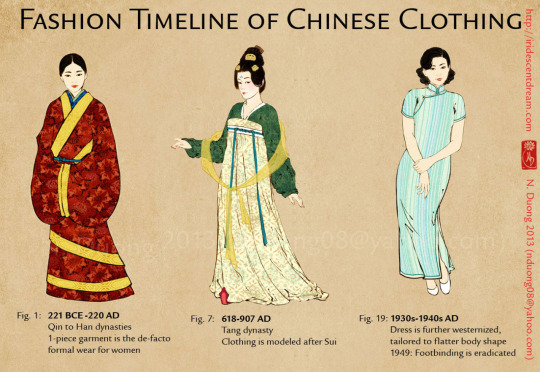
If you like historical Chinese clothing and have an internet connection chances are you have seen these drawings. They have been spread around so much but for some reason I was only able to find out the author yesterday (at time of writing), Nancy Duong from @nannaia. Her website is nancyduong.com. These drawings are so iconic and famous but I don’t really see anybody talking about their accuracy? So I thought it’d be fun to review the drawings as well as the sources used. Ok clickbaity title here, I’m only going to talk about the segments on Ming, Qing and republican era because I know nothing about the others.
Quick disclaimer: none of what I am going to say is a criticism of the artist or her research abilities, as we will see Duong obviously put a lot of efforts into the research and this project was absolutely epic; this will just be a nitpicky review of some of the details which I hope some of you will find useful or enlightening. Also the fact that this was made in 2013 still blows my mind, like I was still a wee child then.
Without further ado, let’s get into it.
Ming Dynasty (1368-1644)
*I’m not yet so familiar with the minutiae of Ming fashion so if anything I say is whack feel free to correct me.
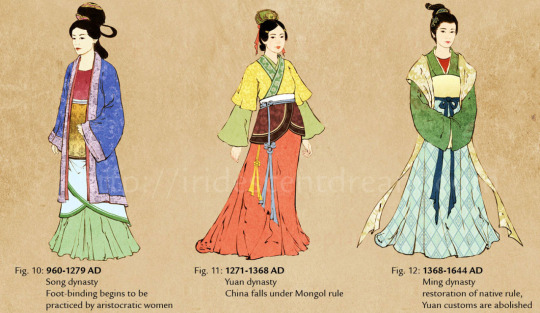
I’ll begin with Fig 12 which is the beginning of the Ming Dynasty. This doesn’t really look like what we think of as early Ming fashion nowadays because I think the reference material she used was likely a 仕女画 shinvhua, a genre of literati painting that featured highly stylized female figures in historicist clothing. The costumes were meant to be excessively flowing and adhering to people’s imaginations of deities or historical figures, meaning that they had little to no connection to what was actually popular in real life. This is a very common misunderstanding for earlier scholars of Chinese fashion history, they just weren’t aware that 仕女画 were not realistic. In her post, Duong mentioned that one of the books she consulted was 5000 Years of Chinese Costume published in 1987, which is very dated and kind of notorious for using a lot of non realistic art as reference for real fashion... In recent years there has been more awareness about what paintings could be used for research and what could not, but in 2013 that was probably too much to ask. So this is more of a sign of the times.

Source here
Ming Dynasty shinvhua by 仇英 Qiu Ying (1492-1552), a renowned painter. For some reason the costumes in most shinvhua feature an apron of some kind tied to the waist and a 披帛 pibo or shawl, perhaps it was a reference to Tang Dynasty fashion. If you see a painting from the Ming Dynasty or later featuring women wearing an apron and a shawl, it’s a huge red flag that the clothing is not realistic. From the Ming Dynasty onward, women wore robes outside of skirts, meaning the waistband shouldn’t really be visible.
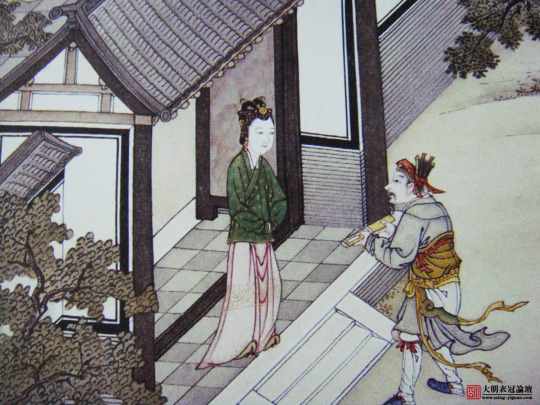
Source here
Closeup of 真武灵应图���, presumably made in the early 15th century, showing the more realistic way of dressing for women in the early Ming.
The other thing here is the caption “restoration of native rule, Yuan customs are abolished”. While that is true on paper, in practice early Ming fashion was full of leftovers from the Yuan Dynasty. A popular decoration style was 织金锦 zhijinjin or gold brocade, a textile manufacturing technique presumably of Persian origin that was immensely popular among the Mongols. I can understand why the first emperor of the Ming would advertise himself as the restorer of Han customs for legitimacy and power, but personally he was a huge fan of gold brocade too ;)
Ok next panel.
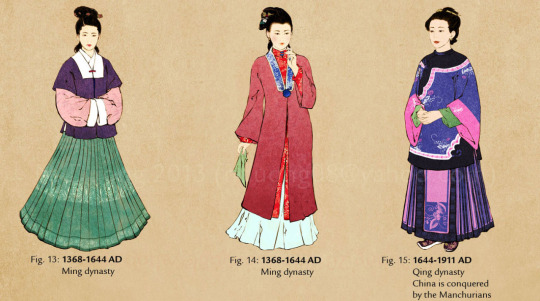
Fig 13 is probably traced from this painting below, which is very legit. The only minor qualm is that Duong seems to have added two 裙襕 qunlan or decorative horizontal strips to the skirt, which are not present in the painting itself. This style of qunlan was common in the early Ming (you can see it in the previous painting) but I’m not sure if it would be acceptable on this particular outfit.
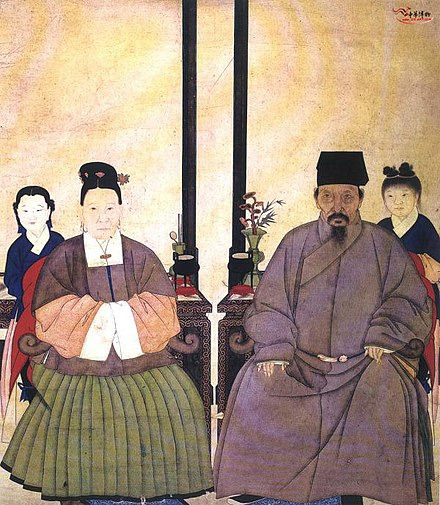
Source here
Next one.

Fig 14 is where it gets interesting and where my niche area of expertise comes in. Duong didn’t specify which part of the Ming Dynasty each outfit was from, but there is at least a 200 year gap between fig 13 and 14, because fig 14 is from the Qing Dynasty... I mentioned this in my review of Evolution & Revolution, I’ll just repeat here. A lot of early historians bought into the rhetoric that the “late Ming aesthetic” continued into the Qing for a couple of years before being obliterated by a mystical form of Manchu inspired dress (something that looks like fig 15 probably). In reality though, that so called “late Ming aesthetic” persisted well into the 18th century until the Jiaqing era when it began to be replaced by a new style, which also wasn’t the stereotypical Qing Dynasty outfit; that didn’t solidify into a thing until the 1840s, at which point the Qing was seven decades away from death. Because of this, fashion from the 18th century often gets mislabeled as Ming. It could be potentially considered hanfu but it’s definitely not Ming... I feel like 17th and 18th century clothing represent the Qing as much as the 19th century does, the Qing is not just the 19th century.
Fig 14 specifically reads very much as Yongzheng era (1720s), with the back heavy hairstyle, tight fitting 披风 pifeng, robe with standing collar and the white skirt. This confusion really isn’t Duong’s fault but more of the book’s. If I analyzed this as Yongzheng era fashion, it would be pretty accurate with the only problems being the sleeve length and button placement. The sleeves are way too short for that era. Before 挽袖 wanxiu or folded cuffs became a thing in the Qianlong era, the sleeves of most Chinese historical clothing were made longer than the wearer’s arms, meaning they had to grab the cuffs to use their hands, creating very beautiful folds and creases when doing that. Also the sleeves commonly had a decorative border similar to that at the collar. The lower button was usually placed at the very bottom of the collar because that would actually connect the collar and the neck area. You see what I mean in the below image.
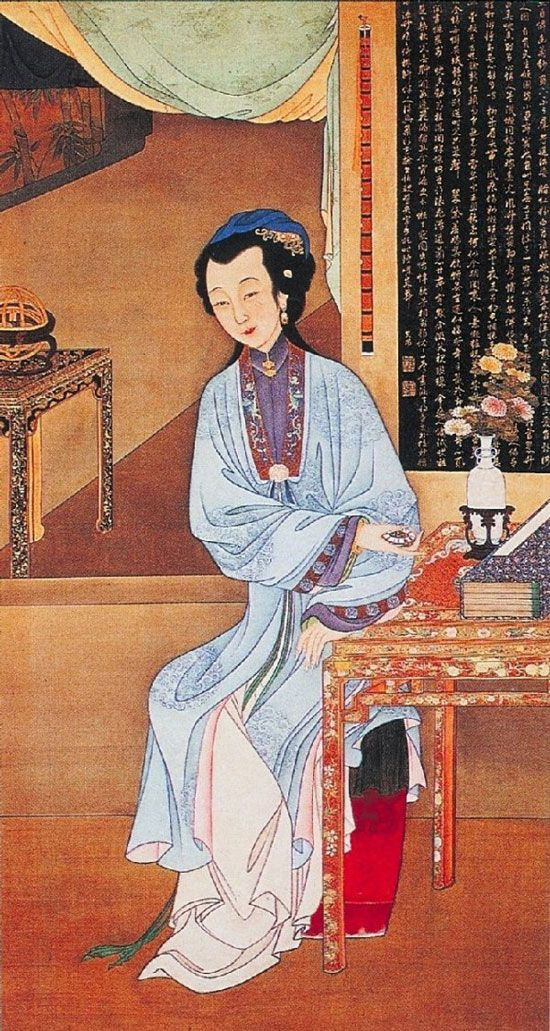
Source here
A painting from the series 雍亲王十二美人图, made in the 1710s/20s. These paintings are full of mysteries and we aren’t even sure who the women (or woman) portrayed really were, but they did depict Han aristocratic women’s fashion realistically. Some of the details resemble late Ming fashion, such as the metal buttons, soft standing collar and parallel collar pifeng, but this is undeniably Qing.

Source here
I think this illustration is from 5000 Years? It’s categorized as Ming Dynasty in the book which is what led a lot of people astray.
By the way, this hairstyle that looks like poop, is from the Yongzheng era as well.
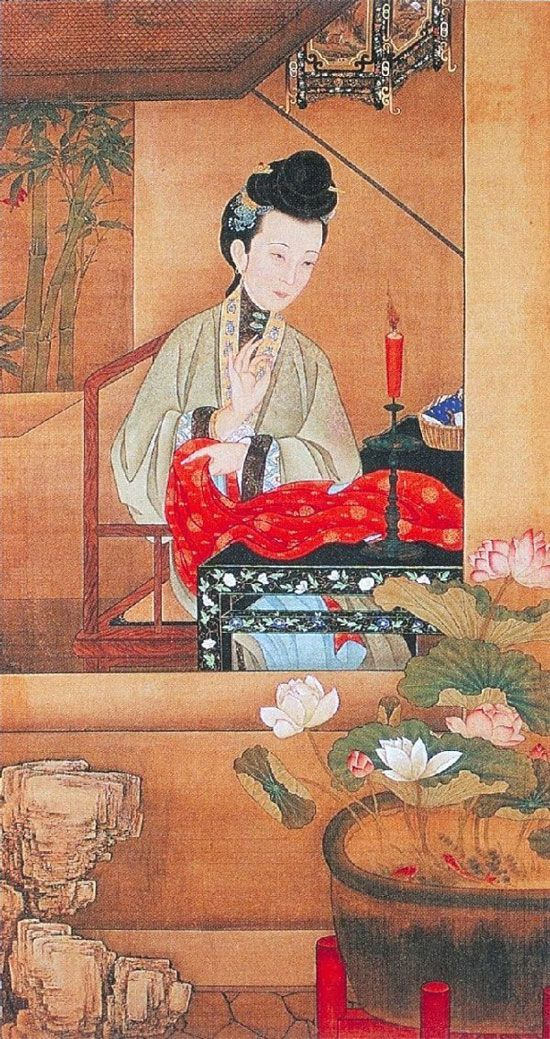
Source here
Also from 雍亲王十二美人图.
Now I can’t just tell you what Ming fashion is not and not tell you what it is. Duong actually neglected huge chunks of the Ming Dynasty in the infographics, like fig 13 is 14something and fig 14 is 1720s. The 16th and 17th centuries are completely missing, which is a shame because they were very beautiful. @ziseviolet has a Ming Dynasty tag with plenty of images, I don’t have a lot of primary images for the Ming so please just enjoy these two:
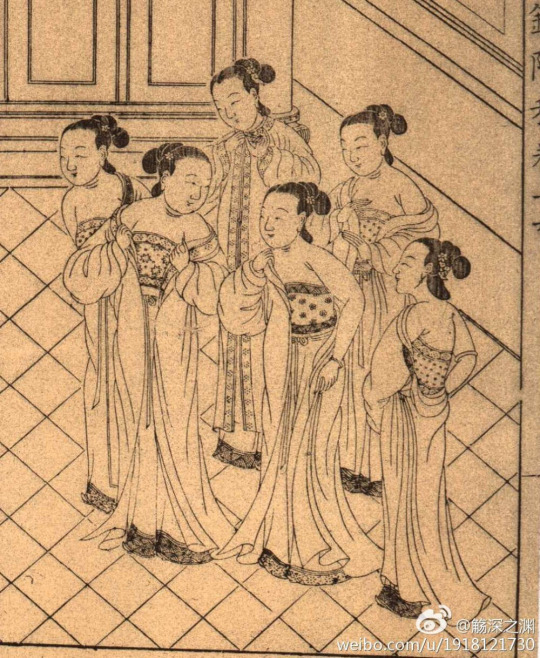
Source here or see watermark
A very particular look from the Wanli era (1572-1620).

Source here
Late Ming, possibly Chongzhen era (1627-44) illustration showing the fad for big sleeves.
Now that I have the drawings out of the way, let’s take a look at Duong’s notes on her research:
“The clothing for women in the Ming Dynasty consisted mainly of gowns, coats, rosy capes, over-dresses with or without sleeves, and skirts. These styles were imitations of ones first seen in the Tang and Song Dynasties. However, the openings were on the right-hand side, according to the Han Dynasty convention.” ((5,000 years of Chinese Costume, pg. 147)
I don’t have this book with me but I think this was pulled from early Ming Dynasty regulations on dress. This is kind of vague; I think the more precise term used in 2021 would be 袄裙 aoqun or robe and skirt, to describe the most common combination worn in the early Ming. “Rosy capes” sounds like a literal translation of 霞帔 xiapei, which was a garment reserved for formal dress and weddings. I don’t think your average woman would roam about the street in a xiapei. The part about the source of inspiration being the Tang and Song is also true on paper, but visually the early Ming was a very different style to the Tang and Song.
Also the thing with the openings on the right hand side. Theoretically everybody in the Ming should wear the openings on the right but in the early and mid Ming because of Yuan customs carrying over, many women still wore robes with closures on the left. It gradually began to be phased out by the mid Ming but was still occasionally practiced well into the Qing and 20th century.
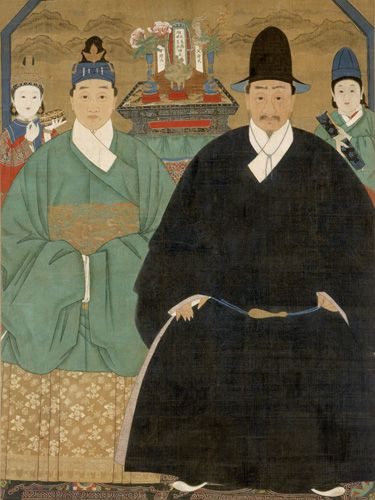
Source here
A Ming portrait featuring a woman in a robe with left closures. I don’t know which decade this is from because I suck at dating Ming clothing uwu I’m opening up about my weaknesses.
“The formal dress for commoners could only be made of coarse purple cloth, and no gold embroidery was allowed. Gowns could only in such light colours as purple, green and pink; and in no case should crimson, reddish blue or yellow be used. These regulations were observed for over a decade, and it was not until the 14th year of Hong Wu that minor changes were made.” (5,000 years of Chinese Costume, pg. 147)
Is this turning into a review of 5000 Years of Chinese Costume... Whatever. Again this is also likely pulled from sumptuary laws which people had completely stopped observing in the mid to late Ming. For the early Ming this does hold true though.
Qing Dynasty (1644-1911)

Not to be rude or anything but wow I didn’t know the Qing Dynasty began in the 1860s. I mean, fig 15 is legitimate Qing fashion and drawn very well but the fact that it’s placed at the beginning coupled with the caption “China is conquered by the Manchurians” suggests that this is what Qing Han fashion looked like since the beginning, which is not true. This look only came into its own in the Daoguang era (1820-50), 180 years after the establishment of the Qing Dynasty. Also the lady is shown with natural feet but foot binding was supposedly at the peek of its popularity in the mid 19th century; although a lot of women didn’t bind, it’d be a more accurate representation of the fashion ideal if bound feet were drawn.

Source here
Export art from the Daoguang era (1820-50). This is earlier than fig 15 hence the higher collar and simplistic fabric.
Next panel.

Fig 16 looks 1880s, which is great in that it shows the progression of time since fig 15. I love that it shows aoku, which was the more popular combination in the late 19th century. The round hair ornament is there (though the tassels are somewhat unnecessary). The bound feet are there. The robe even has the split front trim design, a very nice period detail. The collar is a bit weird though like 1) it should be much lower 2) it should be able to close completely; this kind of collar gap did not become a fashionable thing until the 1900s, but even then the bottom would still be closed because it was made by simply not buttoning the collar not a deliberately designed gap. The sleeves are also too short for the 1880s. Even then this is a well done drawing.
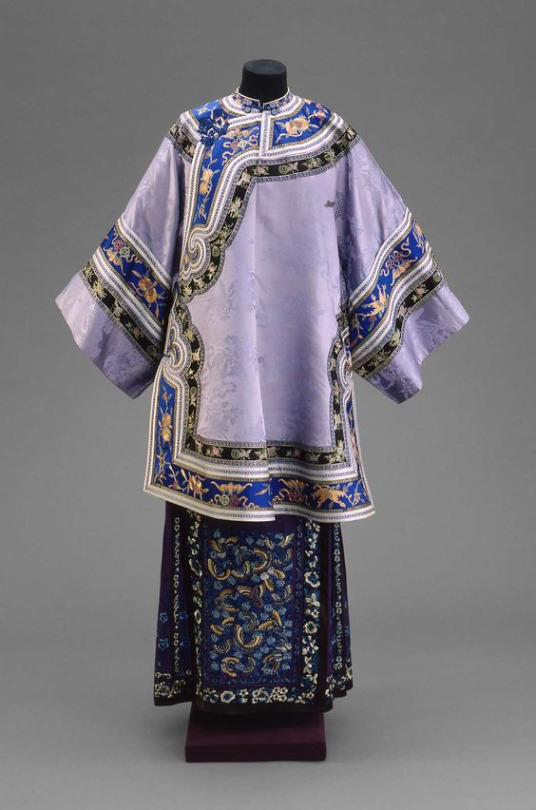
Source here
Aoqun ensemble from the 1870s or 80s. The robe has the split front trim like in fig 16, while the skirt is more like that shown in fig 15 with the rectangular area of embroidery and trimmed pleats.

Source here
The lady on the left is wearing aoku ca. 1885.
My bone with this one is again mainly the caption “The Manchurians attempt several bans on foot-binding but are unsuccessful”. It refers to events at the very very beginning of the Qing, which appears somewhat anachronistic when placed under a drawing of the 1880s... As the Qing progressed the emperors increasingly came to the realization that Han women’s fashion was too powerful to be regulated and just gave up on banning foot binding :0
Although it’s probably not fair to judge this series for what it did not include, I still think it’s really sad that there are only two drawings for the Qing and both of them from the 19th century... I’ll photobomb you with early to mid Qing fashion.

Source here
Kangxi era (1661-1722) painting.
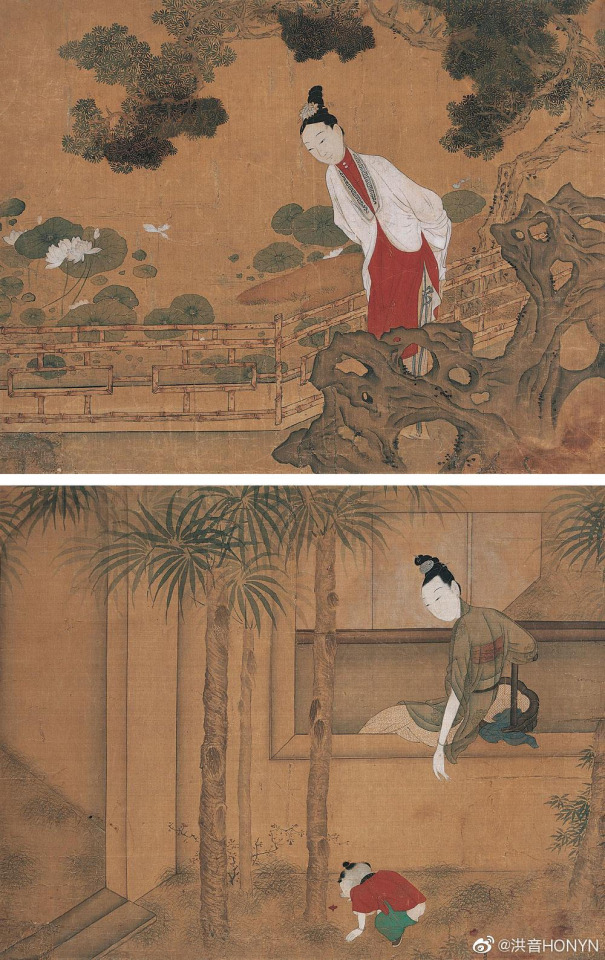
Source here or see watermark
Early Qianlong era (1730s or 40s) painting.
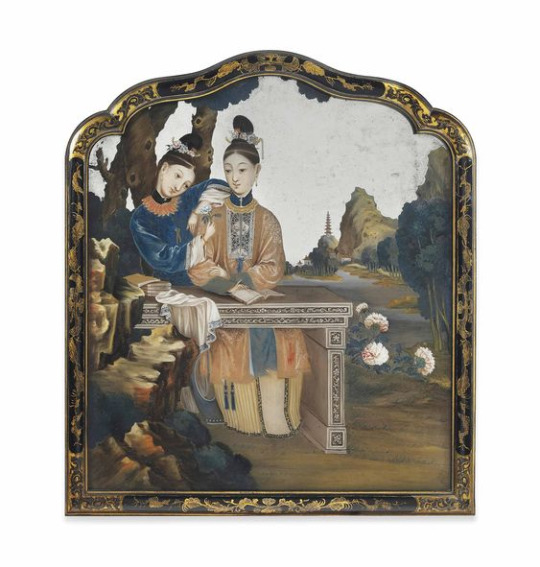
Source here
Mid to late Qianlong era (1750s-90s) reverse glass painting.

Source here
Jiaqing era (1796-1820) wallpaper.
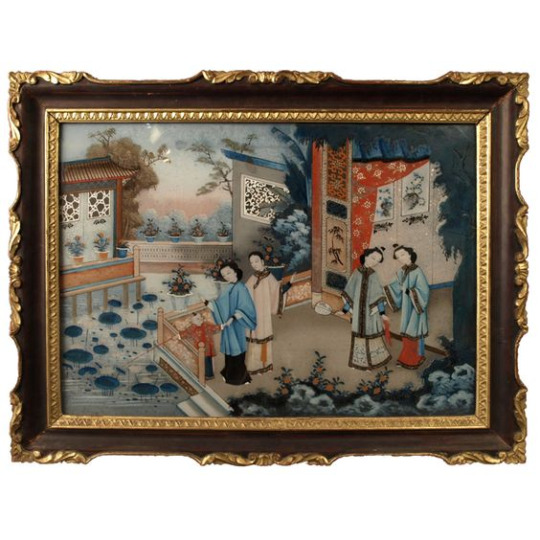
Source here
Daoguang era (1820-50) reverse glass painting.
After fig 15 there should still be two looks, the 1890s and 1900s, for which I have an individual post.

Source here
1890s or 1900s aoku. I think this is from the Hong Kong Museum of History?
Now onto the writings:
When China fell under Manchurian rule, Chinese men were forced to adopt Manchurian customs. As a sign of submission, the new government made a decree that men must shave their head and wear the Manchurian queue or lose their heads. Many choose the latter.
Legit, nothing to see here. Maybe the phrasing of the last part is overly dramatic, since the majority of men opted for the queue and survived.
On the other hand, Chinese women were not pressured to adopt Manchurian clothing and fashions. “Women, in general, wore skirts as their lower garments, and red skirts were for women of position. At first, there were still the “phoenix-tail” skirt and the “moonlight” skirt and others from the Ming tradition. However the styles evolved with the passage of time: some skirts were adorned with ribbons that floated in the air when one walked; some had little bells fastened under them: ...
First sentence completely legit. The red skirt bit is slightly unfounded, the most popular skirts during the Ming-Qing transition were white. “Phoenix-tail” skirt and “moonlight” skirt are probably literal translations of 凤尾裙 fengweiqun and 月华裙 yuehuaqun, neither of which were from the Ming. In fact, I have not yet seen either appear in mainstream fashion before the mid 18th century. Both of these terminologies are kind of vague and to this day I still haven’t found literature giving solid explanations of what they are.
Phoenix tail skirts were likely made by attaching embroidered ribbons of different colors to a waistband. The “ribbons that floated in the air when one walked” and “little bells fastened under them” did not evolve with the passage of time, but were a part of the construction of this garment to begin with. I think they were more of an overskirt meant to be worn over an actual 马面 mamian skirt? Extant examples of phoenix tail skirts from the 18th century existed because they likely took inspiration from theater costumes, notably skirts from the 宫衣 gongyi ensemble worn by royal female characters. I don’t think they became everyday fashion until the mid 18th century, even then they were pretty rare.

Source here
Phoenix tail skirt from the Qing, presumably 19th century.
Moonlight skirts were structurally the same as mamian skirts but every pleat or vertical section was a different color.
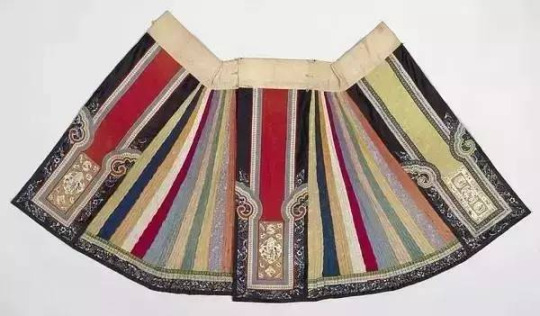
Source here
Moonlight skirt, presumably 19th century.
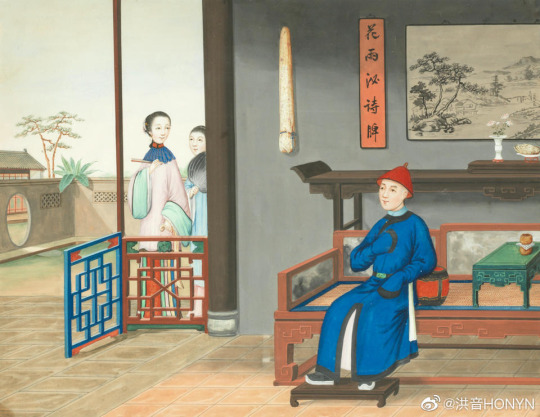
Source here or see watermark
Detail of a Jiaqing era painting showing the lady on the left in a moonlight skirt.
...others had their lower edge embroidered with wavy designs. ...
The “wavy designs” embroidered at the lower edge is somewhat unclear, as it could refer to qunlan used since the early Ming or specifically the wavy shape of the hems in Guangxu era (1875-1908) 花神衣 huashenyi?? It was a type of theater costume and not everyday wear, and also I’ve only seen this wavy design on robes not skirts. If it were actually referring to qunlan or border binding, that has always been used in the Ming and Qing, albeit in different styles in each era.

Source here
Guangxu era huanshenyi costume.
...As the dynasty drew to an end, the wearing of trousers became the fashion among commoner women. There were trousers with full crotches and over trousers, both made of silk embroidered with patters.” (5,000 years of Chinese Costume, pg. 173)
Yess aoku was very popular. It became “fashionable” in the beginning of the 19th century but working women like maids wore them in the 18th century as well.
Republican era (1912-1949)

Ok so republican era fashion was extremely fast changing and convoluted which is why I wrote a whole series on it. If you’re interested in the looks not covered by these drawings do check them out :)) I’m kind of tired of going back and forth and linking all the posts I wrote so if you would like to know more about a specific decade just come back to the masterpost here.
With fig 17 we’re already in the mid 1920s, a decade after the revolution. This is a pretty good drawing, mostly showing the aoqun ensemble correctly. It has the half length flared pagoda sleeves or 倒大袖 daodaxiu, the stiffened collar that closes with one button and the curved robe hem, which are all accurate details. The black mary janes are correct, albeit slightly basic and stereotypical; there were so many cool shoes in the 20s (but hey it’s great that Duong didn’t draw T-straps the arch-nemesis of historically accurate flapper footwear). The hair with the section of bangs is extremely 20s and deserves a medal. There seems to be a low bun at the back of the head, I mean women with long hair did roll up their hair to emulate the short bob but it wouldn’t be so big and rest so low on the head. The skirt is appropriately gathered and flared; however it seems a tad too long for the mid 20s, since most mid 20s skirts were knee or at least calf length. It could also work for 1926-28, but then it would have a more tubular silhouette and the top needs to be shorter and more form fitting.

Source here
Song Qinling and Sun Yat-sen ca. 1926-28. I think this is the vibe Duong was going for? If the skirt were less A-line it would be perfect.
Another (very) minor issue is the lack of binding on the right side of the figure’s neck. It’s very possible that Duong traced this photograph where it isn’t visible because of the shadow, but all Chinese clothing prior to the 1950s had the binding/trim go all around the neck.
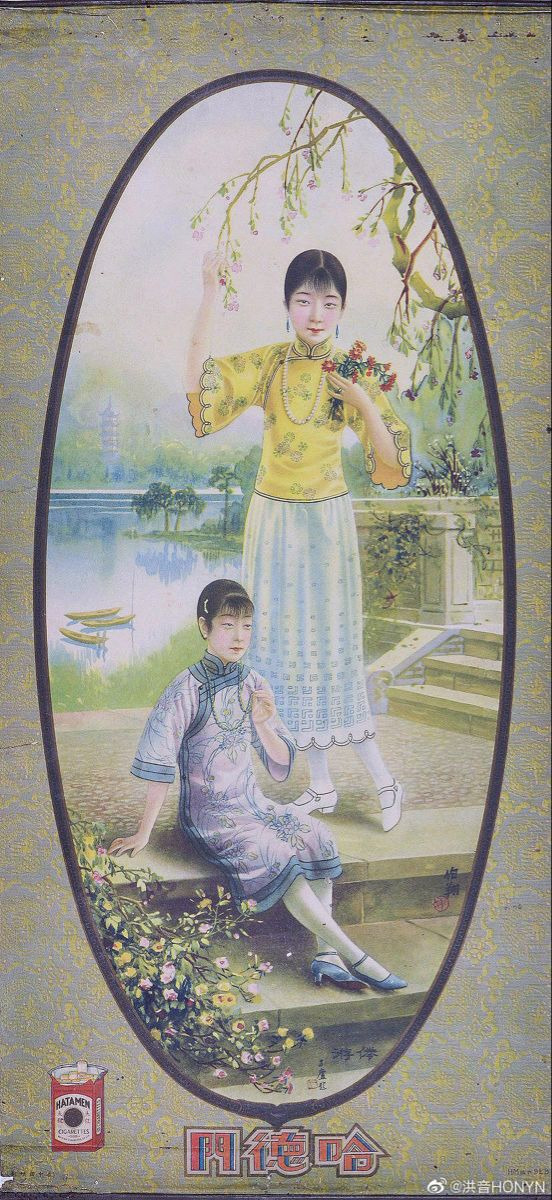
Source here
Painting from around the same time, you can clearly see the trim on the right side of the neck. And look at their gorgeous shoes!
I’ll just quickly address the caption: “1927: Natural Breast Movement; Native attempts on banning foot-binding remain unsuccessful”. The natural breast movement is something people talk about a lot, but aside from their moralistic discourse I’d like to also bring fashion into the perspective. Basically since the Ming Dynasty, Chinese women bound their breasts to flatten them, and in the republican era some people started to think that it was unnatural and unhealthy, so they started to advocate for “natural breasts” in the 1920s. Unfortunately for them, because Chinese women wanted to be more or less on the same page as Western women on fashion and the popular silhouette in 20s Western fashion was also flat chested, Chinese women’s breast curves did not begin to show until around 1933 in high fashion, when breasts were again emphasized in Western high fashion. That’s not to say that individual women did not take off their breast binders, it’s just that the high fashion ideal did not switch to having boobs until the 30s. Changing fashions did what doctors and “progressive” activists couldn’t do for decades, I live for that.
On my usual feminist tangent here, I really don’t like the idea that “natural breasts” is interchangeable with “curvy”? Some women naturally have the flat 1920s silhouette and it’s not like their bodies are invalid. If you want to say normalize curves just say normalize curves, wearing bras and having big boobs are not inherently “natural”...
Still this one is pretty good, next one.

Fig 18 is the cheongsam rendition of the same silhouette as fig 17. In the late 1920s, four styles of womenswear with the same silhouette coexisted, namely 1) the two piece aoqun shown in fig 17, 2) three piece aoqun with vest, 3) long vest with sleeves derived from 2 and 4) the one piece cheongsam derived from 3. The caption is that age old myth about cheongsam being Manchu we can just throw that in the trash. I don’t blame Duong for this at all this myth is extremely widespread. While the cheongsam visually resembles Manchu changyi from the 19th century, it did not evolve from that. Manchu women didn’t give a shit about cheongsam and never wore it either, cheongsam and changyi or chenyi belonged in two very different systems of dress that evolved independently from each other at the time. Also, foot binding became very obsolete among urban “fashionable” women in the 1910s already. It was a very regional practice so it was still done by some women in rural areas or whatnot well into the 20th century, but the high fashion ideal has long switched to natural feet.
The drawing itself is very accurate though, it’s a standard late 20s cheongsam. The hair looks ok as well. The binding is all around the neck this time which is very good. The collar could be slightly higher, especially if approaching the end of the 20s.

Source here
Late 20s cheongsam.
Just gonna quickly show you the 20s three pieces aoqun and vest with sleeves looks not included here.

Source here
Left: three piece aoqun. Right: vest with sleeves.
Moving on to the next panel :3
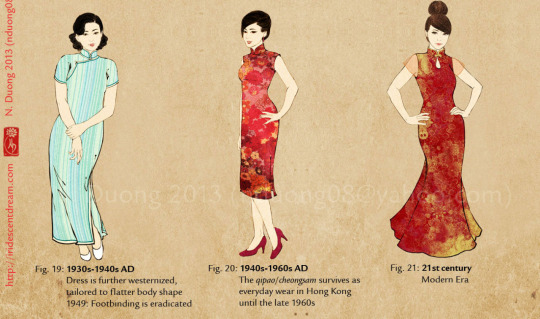
With fig 19 we arrive in the 1930s. With the slightly lower height of the collar and low slits it appears more like the second half of the 30s, maybe 1938-1940ish. This drawing is overall pretty solid. The cap sleeves are there. The binding is in the right places. The shoe shape is appropriate. The rounded edge collar with two buttons is legit. The brush out curls are great.
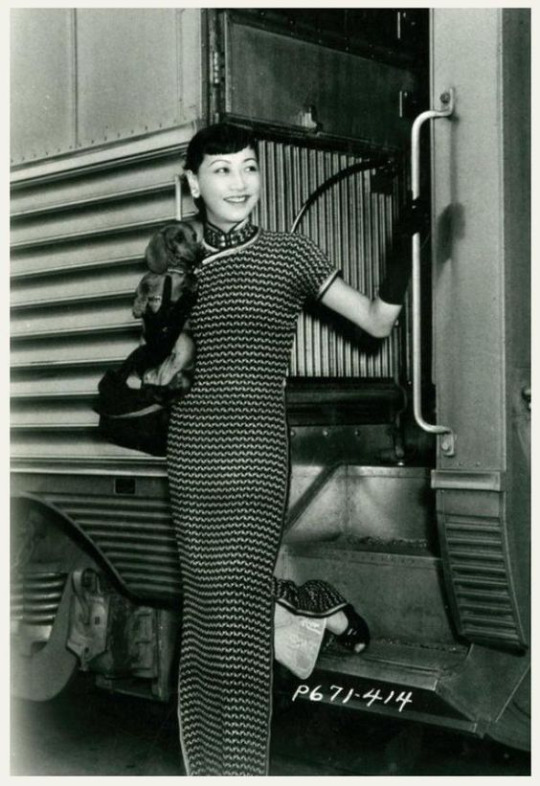
Source here
Annay May Wong in a late 30s cheongsam.
One minor issue it that due to the T shape in which the cheongsam was cut, the pattern at the sleeve part would run horizontally instead of vertically when the arms are down.
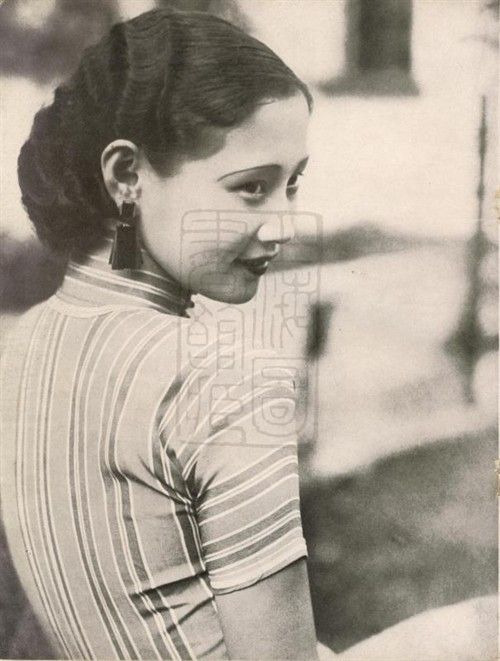
Source here
This is what I mean. This image of Xu Lai is from the early 30s.
Let’s look at the caption: “Dress is further westernized, tailored to flatter body shape. 1949: foot-binding is eradicated”. I guuueeesss you could call the 1930s cheongsam westernized in the sense that it was inspired by the Western evening dress silhouette in that it was long, flowy and slender, but that is not to be confused with “using Western tailoring techniques”. 1930s cheongsam were made completely using the Chinese dressmaking method (平裁 pingcai or flat tailoring). Also “tailored to flatter body shape” is somewhat of a generic and reductive statement, since clothes could show the body shape in a variety of ways using optical illusion and different cuts. The 30s cheongsam was not extremely form fitting to the point that it required negative ease by way of corsets or girdles, it just hugged the body very softly but still left plenty of wiggle space.
I wouldn’t really say that foot binding was “eradicated” anytime anywhere because it was a continuous process not an on or off one, as explained in Dorothy Ko’s Cinderella’s Sisters. Parents stopped binding their daughters after the republican era that’s true, but many older women who had bound in their childhood and found bound feet more comfortable than let out feet continued binding for their own convenience.
Now onto the textual explanation by Duong.
“Ever since the Tang Dynasty, the design of Chinese women’s costumes had kept to the same straight style: flat and straight lines for the chest, shoulders and hips, with few curves visible; and it was not until the 1920’s that Chinese women came to appreciate ‘the beauty of curves’, and to pay attention to figure when cutting and making up dresses, instead of adhering to the traditional style.” (5,000 years of Chinese Costume, pg. 214)
This gives me a stroke. This book is true vintage from the 80s and it never ceases to (negatively) surprise me with incorrect takes. The “straight style” was very much not a thing in the Ming, the authors would know if they looked at the right sources lmao. Curves, what curves in the 1920s? Did you see any curves in the pictures I included of the 1920s? The 1920s flapper silhouette was notoriously flat, unless the flared pagoda sleeves count as curves, in which case most of the Ming and Qing would also be curvy. This is an erroneous stereotype. If you mean “curves” as in showing the shape of the body, in my opinion the 1910s showed a lot more body than the 1920s did. If you mean it as in “curvy” or “hourglass”, then the 1930s was the beginning. If you mean “extreme hourglass”, then the 1950s would be the beginning. More on the 50s later.

Source here
Ca. 1915 fashion, note how tight the robe and pants are.

Source here
1920s aoku, noticeably more relaxed. Still very much flat though.
“The most popular item of a Chinese woman’s wardrobe in modern times was the qi pao. Originall the dress of the Manchus, it was adopted by Han women in the 1920s. Modifications and improvements were then made so that for a time, it became the most fashionable form of dress for women in China.
Already addressed the origin issue: cheongsam was not Manchu. Also aoqun and aoku representation matters.
Two main factors account for women’s general preference for the qi pao: first, it was economical and convenient to wear.” (5,000 years of Chinese Costume, pg. 214-215)
That’s... not true. It was slender and consumed less fabric than older clothing styles so it was more economical for women who were middle class or upward, but the tight, long skirt made it difficult for working women to wear. The cheongsam was largely a phenomenon for privileged women, working women adored the aoku and continued wearing it to the present day. I don’t understand why class issues are seldom addressed in cheongsam discourse.
Women traditionally bound their breasts in the Ming and Qing dynasties with tight fitting vests and continued to do so in the early 20th century.
“The vests were called xiaomajia ‘little vest’ or xiaoshan ‘little shirt” “used by Chinese women as underclothing for the upper part of the body.” (Changing Clothes in China: Fashion, History, Nation: Finnane pg 162) “Doudu [is] a sort of apron for the upper body […] in former times the doudu had been worn by everyone, old and young, male and female. The young wore red, the middle-aged wore white or grey-green, the elderly wore black. A little pocket sewn into the top was used by adults to secrete them money and by children their sweets. When a girl got engaged, she would show off her embroidery skills by sending an elaborately worked doudu to her fiancé, decorated with bats for good forturne and pomegranates, symbolizing many sons.” (Changing Clothes in China: Fashion, History, Nation: Finnane pg 162)
This part is incredibly legit, mostly because Duong cited more reliable sources. Thank you for releasing me from the hell that is 5000 Years.
A ban on bound breasts began in 1927, in which the government started advocating for the “Natural Breast Movement”. Despite this, bound breasts still widely continued into the 1930s. The government also banned earrings as it fell under the criteria of deforming the natural body. The 1930s also saw the introduction of the western/French bra come to Shanghai.
Ok I didn’t even know about the ban on bound breasts, most fashionable women had quite flat breasts up until 1933. The earrings ban too, like earrings seemed very popular throughout the republican era.
“The little vest was designed to constrain the breasts and streamline the body. Such a garment was necessary to look comme il faut around 1908, when (as J. Dyer Ball observed): ‘fashion decreed that jackets should fit tight, though not yielding to the contours of the figure, except in the slightest degree, as such an exposure of the body would be considered immodest.’ It became necessary again in the mid-twenties, when the jacket-blouse—a garment cut on rounded lines – began to give way to the qipao. At this stage, darts were not used to tailor the bodice or upper part of the qipao, nor would they be till the mid-fifties. The most that could be done by way of further fitting the qipao to the bosom was to stretch the material at the right places through ironing. Under these circumstances, breast-binding must have made the tailor’s task easier.” (Finnane 163, Changing Clothes in China: Fashion, History, Nation)
Woww this part is actually really good I’m impressed! Yess the little vest was worn to alter a woman’s body to fit the fashionable flat silhouette. I love how Finnane acknowledged that darts were not used on cheongsam until the 50s and shaping could only be achieved by 归拔 guiba, stretching the fabric and ironing the shit out of it. I’ll explain it in more details when I post about making a 30s cheongsam (still waiting for the pankou currently 😠).
Successful eradication of bound feet would not come until the 1949 when the People’s Republic of China came into power.
Already addressed, foot binding was never eradicated as in it died in a blast or something.
Post republican era

The cheongsam in fig 20 has the right idea but could do with some more extreme proportions. It’s titled 1940s to 1960s but the 1940s were a very different silhouette to the 1950s and 60s in that it didn’t use Western tailoring techniques and had a very very low collar. The hair is difficult to decipher as it doesn’t vaguely resemble anything worn in the 1940s-60s? I’m gonna interpret this as 1950s and 60s because of the caption “The qipao/cheongsam survives as everyday wear in Hong Kong until the late 1960s”, suggesting that it was already “extinct” in the mainland according to legend (it was not though, see my post on 1950s mainland China). A 50s/60s Hong Kong cheongsam would have a much, much more extreme hourglass shape, even for everyday wear. The boobs would be pointy not round because of bullet bras. The waist would be violently (positive) cinched in. The hips would be emphasized and the skirt hem would taper inward. The collar is on the right track with the v shape gap but could be a tad taller. The stiletto heels and the slit length are appropriate as well.
As for hairstyles, large brush out curls forming a round coiffure was popular in the 50s while tall beehive hair dominated the 60s.

Source here
1962 Hong Kong cheongsam.
Text time.
Under the People’s Republic of China, very few mainland women wore the cheongsam, save for ceremonial attire. Clothing became de-sexualized for mainlanders.
Stereotypes, stereotypes, stereotypes. Cheongsam has always been worn by only a few (privileged) women, it’s just that in the republican era they were overrepresented in popular media. The bulk of the Chinese population consisted of peasants who wore aoku. In the Mao era, urban housewives continued wearing cheongsam into the 60s because that was a part of their lives. I wonder what is meant with “de-sexualized” cause no item of clothing from the republican era was sexualized to begin with?? Maybe they meant sex as in gender, in which case no clothing in the mainland was not unisex, if you were a guy wearing a dress (platye in the 50s) you would probably be stoned on the spot (over exaggeration here to describe the dangers of transphobia).
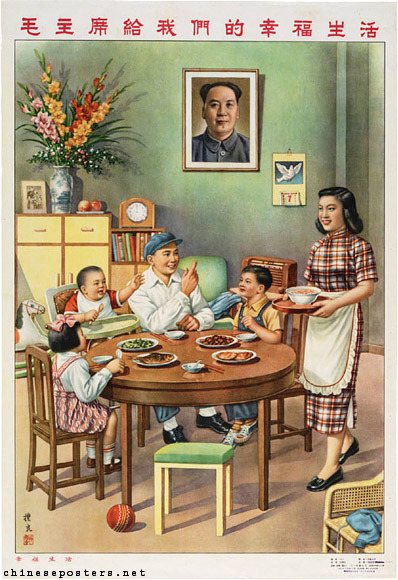
Source here or see watermark
50s mainland housewife in a cheongsam. You can also see with the children that the girl is wearing a skirt and the boy a pair of pants, gender denominators were not dead.
Another feminist tangent because this is my blog. I hate how fashion historians describe the masculine looking uniforms and “Mao suits” in the communist era “androgynous” like no they weren’t fucking androgynous they were masculine. Androgyny means showing both masculine and feminine elements but somehow feminine fashion is never represented in “androgynous clothing”. Don’t try to pull that “uhh feminine clothing is not practical” card, like so what? Does the definition of “androgyny” include “practicality”? Obviously not, it’s just an excuse to exclude femininity. It’s that age old misogynistic thing of treating masculinity as the neutral norm or “not having gender” and femininity as the cursed variation with gender added to it. If clothing in the communist era was truly unisex or androgynous, why do we have no evidence of cis guys roaming about the streets in cheongsam or platye?? I think a lot about this video on androgyny by Jade Fox.
It was the flip side in Hong Kong, as the cheongsam continued its function as everyday wear which lasted until the late 1960s. The cheongsam in the 1950s and 1960s became even tighter fitting to further accentuate feminine curves. Western clothing became the default after the late 1960s, though the cheongsam continued to survive as uniforms for students (who donned a looser and androgynous version), waitresses, brides, and beauty contestants.
This is all pretty standard and correct, my only two bones to pick are the “feminine curves” and “androgynous version”. I already explained my problem with modern interpretation of androgyny, a looser cut does not equal androgyny. The thing about feminine curves is true on the surface but if you think deeper about it the 50s/60s cheongsam doesn’t show the “real”, biological female body but rather an hourglass ideal artificially created by shapewear that people are taught to perceive as feminine. The Hong Kong cheongsam didn’t accentuate feminine curves so much as invent them, because curves are not a necessary prerequisite for femininity anyway. There is absolutely nothing wrong with this, fashion is all about different silhouettes, but can we just stop giving inanimate pieces of fabric or shapes gender like all of this belongs in r/arethecisok.
I’m not gonna analyze fig 21 because everything was possible after the 1970s and this drawing looks pretty good. That’s all :))
Conclusion
Woah this got long. I had a lot of fun reviewing these drawings and I would say that overall Duong did a very good job for 2013 (please do not kill me I mean no harm :.3). The main takeaway here is to not consult 5000 Years of Chinese Costume for anything ever, it leads only to pain and tears... I guess this post also functions as a partial review of 5000 Years then? I should rate it too. Solid 3/10 from the passages included here, would not recommend. If you want to learn about Chinese fashion history, read more recent books, at least from 2000 onward the bar is very low.
598 notes
·
View notes
Note
hi, clara! i’m starting french class next week and school.. but no one needs to hear about my panic and i was wondering what are your favorite french shows, musicals, or movies, etc? i want to surround myself with the language to hopefully be more comfortable with learning it in class and i thought going for its entertainment would be the way to go!
✧˖°࿐ ohh nixie, you did not get me started on french musicals... jk jk but first of all, good luck with french classes! and second, most of this might be intimidating at first (it was made by and for francophones, so you will probably be intimidated by the language if you're a beginner) but you will understand and learn in no time, don't worry!
➤ french shows;
this department is pretty scarce because i don't watch many french shows (mainly because i've been traumatized by a few that were very cringey, oops) but here are some i recommend/have heard are really good:
Kaamelott (2005-2009). i absolutely have to mention this one because it's more than a comedy show, it's a staple of french culture - I've yet to meet someone who's never seen at least one (1) episode. it started off as a comedy show about king arthur and his quest for the grail, but in the latter seasons evolved in a much more compelling and layered fantasy story that deals with magic, depression, and suicide. it's made by Alexandre Astier, who is kind of like our LMM except he writes plays instead of music and doesn't have ~controversies~ or whatever. also a much-anticipated (for 10 years) Kaamelott movie came out just now in theaters!
Lupin (2021-). also very famous but in a widely different register. I haven't seen it yet but only heard good things about it, and it has the merit of starring Omar Sy who is everyone's favorite actor. it's about this thief and son of a wrongfully accused man who sets out to get revenge on the rich businessman who put his father in jail, using his knowledge in forgery and theft to expose the entrepreneur's crimes, all while being inspired by French literature hero Arsène Lupin. it will give you great insight into french society today (also features a lot of useful and accurate slang) as well as really beautiful shots of Paris!
Le Bazar de la Charité (2019). a historical drama mini-series about the true event of this fire that ravaged a charity event in Paris and killed many. I haven't seen it either, though I really want to, but I've heard good things about it, and the historical accuracy is probably best since it's a show about French history written by French people. also, features Camille Lou my beloved <3
lastly, here's an article on French tv shows that you can all watch on Netflix! (though I wouldn't recommend Emily in Paris unless you want to get eczema from second-hand embarrassment, lol)
➤ french movies;
similarly to french shows, I haven't seen that many (though I have seen more) because french cinema has the reputation of being... either Not Good (read: Really Bad) or Really Pretentious And Incomprehensible. but there are some really good films that I have to mention:
first, of course, the staples of comedy that every French person has seen, and will earn you shocked gasps of "you've never seen X??????": Astérix et Obélix Mission Cléopâtre, La Cité de la Peur, OSS117, Les Visiteurs, Bienvenue chez les Ch'tis and many others... namely everything Louis de Funès has ever done. it's definitely... absurd humor or parody for the most part, because it's what we like best, but personally I think the first two movies are some of the funniest things I've ever seen so I can attest to their quality.
of course, Intouchables, which was the highest grossing French film of all time for a while and remains the most-viewed French film abroad. Also starring Omar Sy (♡), it was his breakout success actually; it tells the story of this very wealthy quadriplegic man who hires a young man from the "rough area" to be his live-in aid; you may have seen the American remake The Upside, but... nothing beats the original.
Personal recommendation here: Le Chant du Loup (ALSO HAS OMAR SY MY BELOVED!). It's a military thriller about a recruits in a submarine and especially this one soldier who is the "Oreille d'or" (gold ear) and can basically identify any enemy vessel or animal based on the sound they emit alone. it's a veeery tense film (reminded me of Nolan's work esp. Dunkirk, which is one of my favorite movies!) with high stakes that I truly enjoyed; and I have... contacts... who know people... who know stuff... can't say much more before the State finds me lol but even though some parts are very far-fetched, the military jargon and procedures are pretty accurate to the reality of a submarine!
Cyrano de Bergerac. It's the most famous adaptation of the eponymous play, which is a legend of French literature. The whole movie is in verse, taking its dialogue directly from the text of the play. 100% recommend if you're into beautiful literature, swashbuckling stories, passionate tragic romances and antiheroes. Would recommend watching this when you're more advanced in your French-learning journey, and reading the book first, because the language is dated and formal, but incredibly beautiful and it would be a shame missing out on the poetry!
a special mention for animated movies that were all of my childhood, and also that of many French people of my generation: Azur et Asmar, Kirikou et la Sorcière, Kirikou et les Bêtes Sauvages. Imo children's movies are the best way to learn your target language because they use tropes and archetypes that are easy to recognize, are often super whimsical and entertaining, and don't feature super technical concepts or vocabulary.
On a related note: Disney movies!!! I can't stress this enough: watch Disney movies in French!!! you probably know them already by heart and will learn the language super fast by learning the songs. or if you can't watch the movies, just listen to the songs. Watching Tangled in German was an amazing experience for me.
➤ french musicals;
should probably preface this by saying french musicals are scarce compared to broadway ones, because France has a culture of classic theater much more than musical theater. the songs are more poppy and less extravagant belting fests, but not any less entertaining!
Notre-Dame de Paris. Based on Victor Hugo's Hunchback of Notre-Dame, it's one of the most famous French musicals and the closest to a Broadway one I'd say. Features huge names of the Francophone musical scene in the main roles (Garou, Daniel Lavoie, Hélène Ségara and Patrick Fiori are all famous outside of their roles). the story is very famous of course but still a joy (or a pain, because it's just so sad) to follow. Most famous songs: Belle, Le Temps des Cathédrales. (Both of these have transcended the musical sphere and are well-known through all of France even by those who really despise Broadway)
The original production of Les Mis was French as you probably know, and it's worth checking out! Especially À La Volonté du Peuple, which is the original Do You Hear The People Sing? I've talked about the lyrical differences between the two versions and how they evidence different characterizations of Enjolras and Les Amis, but the truth is it's just really good in an "empowering anthem" type of way. Also I will literally never recover from Michel Sardou as Enjolras like I think that's so funny and,,,, ill-fitting but also not like asdkdjdj
Mozart, l'Opera Rock. which as the title suggests is a rock opera about Mozart's life and his rivalry with Salieri, but if Mozart and Salieri were vampires with a gay bdsm relationship lowkey. this is NOT what happens in the musical in reality but the subtext is THERE asixdjsj. the songs are ICONIC and so is the aesthetic, more than one French kid's bisexual awakening before we got Måneskin tbh. Most notable songs: L'Assassymphonie (an absolutely canonical BANGER), Tatoue-Moi, and my favorite, Le Trublion.
1789, les Amants de la Bastille. It's my favorite and it's most definitely not the best but I hyperfixated on it when I was 10 and my life has not been the same since. I mean, star-crossed lovers during the French revolution??? Hello???? Camille Lou my beloved is here (remember, from the Bazar de la Charité?), also Louis Delort on whom I had a little bit of a crush ngl. (actually had a crush on both but s: Ça Ira Mon Amour (my favorite since 2012 😔🤟), Pour la Peine, and just like. Generally all of them are bangers
Roméo & Juliette. pretty self-explanatory as to what it is about, I've never listened to all of it, just the most famous songs, but what I know from it is SO GOOD, I have this friend who is the most dedicated fan of this musical so I had to mention it. Les rois du monde and Vérone are a bop and a half! Big Broadway vibes with this one musical, with super talented singers and ensemble casts giving it their all, so I'd recommend starting with this one (or the first two I mentioned) if you don't want to feel too out of the water.
there's also Le Roi Soleil which is about the life of Louis XIV in Versailles and it's very very famous probably on the same level as Mozart or Romeo & Juliette and it has Emmanuel Moire in the lead role and I Respect and Cherish him but I never really cared for it? Je fais de toi mon essentiel is still super famous so I'm including it here and the costumes & staging are great!
I'm forgetting many (La légende du Roi Arthur, Robin des Bois...) but these are the main ones. My musicals playlist has all my musical faves, and a good proportion of them are in French! (And you will find some familiar faces in English, too.)
➤ and one last rec;
read the Little Prince.
I'm dead serious, read The Little Prince in French (which isn't the original version, funnily enough). Not only is it one of my favorite books ever, it's also one of the most well-known and widely-translated works of French literature. You've probably already read it in your native language and if you haven't, it's really easy yet incredibly poignant and full of truths about life and philosophy. I treasure this book with all my heart, and it was the first book my mom read when she was learning French. It helped a lot!
I really hope this is useful! tell me if you need anything else. and good luck! 💜
#french#france#langblr#french movies#french literature#french shows#french music#french musicals#french language#french resources#˚₊·͟͟͟͟͟͟͞͞͞͞͞͞➳❥ nixie
100 notes
·
View notes
Text
Country, horror and ancient Egypt - films of the weekend!
This has been some film week! And I’m so glad. After a summer of binge-watching a variety of TV series, last weekend turned into a nostalgia-filled movie marathon. Not just because of the choice of movies, but because of the deeply reminiscing feeling I get when watching a movie in mid-day on a Saturday. It’s just something so 2002 about that for me.

So where did my eyes wander? Well, starting out with Walk the Line, the Johnny Cash-biopic from 2005 that made Joaquin Phoenix’s star shine brighter. Sure, he had a string of great roles behind him at that point, however as the Man in Black he really was able to shine. I saw this movie at the cinema and loved it instantly. It has since been coming along with me through its DVD and it is one of those movies that requires, no demands, several re-watches. But watching it now, I realize, maybe 16 years too late (but hey, I’m trying over here), that I shouldn’t just call it a Johnny Cash-biopic, when in fact it’s just as much a June Carter-biopic. With this role, Reese Witherspoon got her She’s-actually-a-fantastic-actor-and-should-not-get-stuck-in-comedies-role. With the risk of sounding condescending, I really mean what I’m saying here. As wonderful as she is in Legally Blonde, it’s the honesty, vulnerability and fierceness that she brings to June Carter’s story that makes this movie all the richer. The chemistry between Phoenix and Witherspoon makes this more than another music biopic or a story about famous musicians – it’s a love story, pure but not so simple as that.

The weekend continued with one of the most riveting and intriguing horror movies of the last decade – The Conjuring. With it’s well-written scares, real characters and… You know what, I can’t write much about this one, sorry. It’s just too scary to be sitting up late at night when my love has gone to sleep and I’m up on my own. What if by writing about it I actually do what the title suggests and…conjure something? Anyway, I power through just to mention the film’s interwoven old and new (well, 1970s) horrors and the on-screen movie couple I can’t get enough of – Ed and Lorraine Warren played by Patrick Wilson and Vera Farmiga with ever-present strength and tenderness. It’s a treat for any horror fan and thanks goes out to James Wan for creating a horror film one actually wants to watch again. Although sometimes I truly wish I didn’t…! :-O :-O

After such a horrific re-watch you must understand my need for running back to safety the next day by watching an animated story from past childhood weekends. Now it was time for The Prince of Egypt to part the horrors of my Saturday night, just like Moses parted the Red Sea (Spoiler alert!? Really?). And just like when I would watch it as a kid, I didn’t do much reflecting on its historical or religious (in)accuracy – sorry – and instead enjoyed the glorious animation and dramatic score. I was always fascinated with the hair of the ancient Egyptians, underscored by this movie’s animation and style. I used to be shocked when the movie showed everyone in the palace didn’t have the same large round set of pitch-black hair, which would always stay in place with no hairspray. No, it was all wigs! No matter what you think of the movie and it’s subject matter, we can all agree that there’s one thing this movie brought to the world for which I will always be eternally grateful. Truly, this movie was never really all about the stand-off between Moses and Rameses. It’s the coming-together of two of music’s giants, Whitney Houston and Mariah Carey, in their duet ”When You Believe”. This has been my go-to-song when I’ve been in need of that perfect combination of movie soundtrack, a commercial hit and endless wailing and melisma. Thank you, Moses!
HT
#movies#films#film blog#movie blog#20th Century Fox#Warner Brothers#DreamWorks#horror#joaquin phoenix#reese witherspoon#james mangold#patrick wilson#vera farmiga#james wan#the conjuring#walk the line#the prince of egypt#whitney houston#mariah carey#johnny cash#june carter#june carter cash#garbogreenlemons#Garbo Green Lemons
6 notes
·
View notes
Link
The Crown's talented cast and period-drama allures have made it one of Netflix's most successful shows in recent memory, with two more seasons on the way. Since The Crown's characters are based on real people, it was necessary from the start to find actors who could convincingly pull off the show's long lineup of famous historical figures. One of the most important ingredients in this is height, specifically how tall the actors are compared to their real-life counterparts.
In casting the series' principal characters across its four-season run, The Crown has ended up with a wide variety of actors both short and tall; these ones all lean favorably into one of those two sides. Unless otherwise stated, all heights for both actors and royalty are taken from their IMDb bios.
10. SHORTEST: Helena Bonham Carter (5'2")

[...] Bonham Carter stands at just 5'2", making her the shortest actor in the show's cast, but a perfect fit for the role of Princess Margaret, who was 5'1"
9. SHORTEST: Gillian Anderson (5'3")

8. SHORTEST: Claire Foy (5'4")

[...] She stands at 5'4", the same height as the Queen herself.
7. SHORTEST: Victoria Hamilton (5'4")

[...] the actual Queen Elizabeth was somewhat shorter, coming in at 5'2" compared to Hamilton's 5'4".
6. SHORTEST: Lia Williams (5'5")
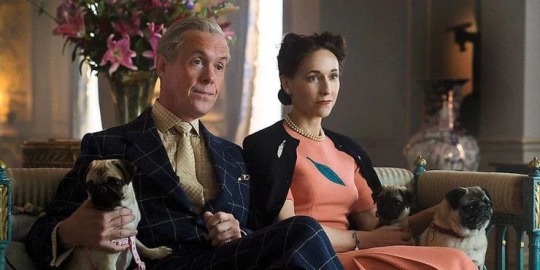
The Crown cast English actress Lia Williams as Wallis Simpson, the Duchess of Windsor. Though Williams is 5'5" tall while the Duchess herself was only 5'2", the height difference isn't too noticeable, thanks to the show's incredible cinematography and Williams's captivating performance.
5. TALLEST: Alex Jennings (6'2")

Alex Jennings was cast as Edward VIII, The Duke of Windsor, on The Crown, though his height of 6'2" makes him noticeably taller than the former monarch he's portraying, who was only 5'7".
4. TALLEST: Jeremy Northam (6'2")
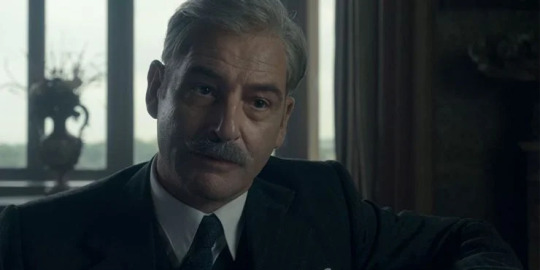
Standing at 6'2", actor Jeremy Northam is about two inches taller than the historical figure he portrayed on The Crown, politician Anthony Eden.
3. TALLEST: Matthew Goode (6'2")

The Crown's Matthew Goode earned a Primetime Emmy nom for his role as Princess Margaret's husband, 1st Earl of Snowdon Antony Armstrong-Jones. Goode, at 6'2", is nearly nine inches taller than the Earl was (according to the New York Times), but given the strength of his performance, he should be allowed to bend the rules of historical accuracy at least somewhat.
2. TALLEST: Charles Dance (6'3")

Charles Dance plays Lord Mountbatten on The Crown. Though Dance's 6'3" stature makes him taller than the 5'11" viceroy, he's a prolific-enough actor to be able to carry a role without fitting into the character's shoes, so to speak.
1. TALLEST: John Lithgow (6'4")

John “plays 5'6" British Prime Minister Winston Churchill (surprisingly, it works).”
______
*Coincidentally Matt Smith is 6′0″ and Prince Philip is also 6′0″. (Tobias Menzies is 6′1″.)
#the crown#claire foy#helena bonham carter#gillian anderson#matthew goode#jeremy northam#charles dance#john lithgow#alex jennings#the crown netflix
37 notes
·
View notes
Text
okay i have opinions
about the costumes of BBC’s The Musketeers, because look. It’s clear the costumer knew what they were doing, and so did the hair department. Ryan Gage and Alexandria Dowling’s costumes were superb (in terms of staying true to the vibes of the 1630s) throughout the series. In fact, they clearly did their research because Louis XIII was famous for going clean shaven, going so far as to command his entire court to shave their faces as well in 1628 and enforcing the style of short, pointy goatees, but I digress.
The point is, the costumer had a Specific Look in mind when they made the costumes for the the main four musketeers we’re supposed to care about. And the costumes themselves look good, the hair looks good on the actors, and I would really dig it in literally any other context.
But this is Paris, the fashion capital of Europe at the birth of the Baroque period. Which means we were robbed of the following
- flat lace collars
- boot tops turned down to show off lace-trimmed silk stockings
- bright colors
- garters (god I love garters) with bows.
- long flowing hair
- r i b b o n s
you see where I’m going with this? black and brown leather doublets (and whatever the fuck d’artboard was wearing in season 3) are... fine, but you can fit so much character development and world-building into costume, especially in an era where you’re allowed to go absolutely buckwild with said costumes. Let me explain further.
Our main four definitely share clothes. This should be obvious to the audience. Especially when d’artboard arrives in paris and is not yet acclimated to the fashion scene the others probably loaned him accessories.
Athos, being Athos, would probably have the most subdued style of all of them. d’artboard (and all of them, really) might start wearing darker colors after they got married (although I’m not sure of the historical accuracy of this bit. i remember reading something like that when researching fashion history of the era but it was a decade or so off and focused on dutch fashion so idk if that really applies here). historical validity of that statement aside, darker palettes are associated with maturity and somberness by our modern sensibilities and would be a good way to signal a change of tone to the audience without sacrificing the feel of the clothing of the area.
the job of barber-surgeon is one that could have totally been brought in for character-building purposes (aramis would make regular trips to keep his hair looking crisp cause you know he would) and also for comedic effect, like, imagine if early in the episode aramis gets an immaculate shave and a haircut (two bits) courtesy of lemay, only to have lemay rush back in to patch him up from a bullet wound or something. they could have made jokes about that. I would have laughed, I’m very easy to entertain.
I also think that d’artboard could have grown a full 1630s goatee in season 3. I love intentional stubbly looks as much as the next bi trash but the pointy goatee is also very good and luke pasqualino could have absolutely pulled it off, so why not go all the way?
Also, they went with the long-but-still-short hair for 3/4 of the musketeers we’re supposed to care about. They could have gone for the full shoulder-length flowing locks, but didn’t cause they’re cowards i guess. Again, I see and appreciate the validity of starting d’artboard looking intentionally out of place to highlight his youth, immaturity, lack of experience, and need to prove himself in the beginning. Porthos and his magnificent curls are exempt from this cause the bandana look slaps.
there was no point to this essay.
#bbc's the musketeers#the musketeers#historical costume#d'artagnan#athos#porthos#aramis#luke pasqualino#i have adhd can you tell
51 notes
·
View notes
Note
I get so embarrassed when I see history fans talking about different Boleyns. Like, talking about her characterization on The Tudor, on The Six Wives of Henry, on Henry and His Six Wives etc. And then they get into Six and are like "... this Boleyn is a little bit different than the others, she isn't so strategic... actually she's not very smart". Like, we the fandom can say "If you pay attention and look at the script and watch the full bootleg, she's actually quite smart". But we can't ignore the fact that people that are not Six fans, and just Tudor times fans in general won't do all of those things. Boleyn is the most famous wife, so DLYH will be the song people will know the musical for, and we can't expect them to think "No, she's actually lying and dumbing herself down to win the audience's sympathy"
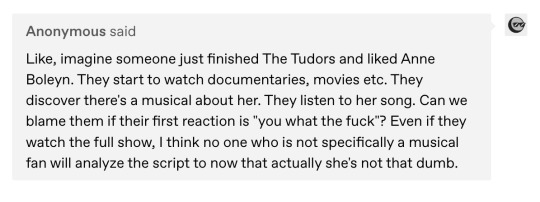
Firstly I’m not blaming anyone for their initial reaction to or their opinions or Don’t Lose Ur Head. If someone dislikes Boleyn’s portrayal in Six the musical then that’s completely fine, I’m not going to say that their opinion isn’t valid. My posts about Boleyn in Six aren’t for people who don’t like the musical, they’re for people who are already in the fandom. I wouldn’t expect non-fans to analyse the script of Six or the album because its not something their interested in. Six, like every other piece of media that has ever existed, is entirely subjective and I can totally understand why people would dislike Six and the characterisations of the queens. All I ask in return is that non fans respect that many people do like Six and enjoy the show as a whole and listen to us when we point out that maybe it isn’t as clear cut or things aren’t as immediately obvious as they first thought.
Here’s the thing about The Tudors though: yes, they had a fantastic version of Anne Boleyn and I adore Natalie Dormer in that role...but then I personally feel that same show completely butchered Katherine Howard. On the other hand, a lot of people agree that Six’s strongest asset is All You Wanna Do and it’s portrayal of Katherine as a victim rather than a villain. I will admit that I really disliked the portrayal of Howard in the Tudors when I first came across clips on YouTube. However, until I had seen the entire show, I refrained from forming a full opinion on her character and on series four of the Tudors as a whole because I knew it was unfair to judge an entire series by only a few clips. I still personally believe that they did Howard a massive disservice, but there are one or two good elements here and there that I wouldn’t have discovered unless I watched the whole show. I waited until I had access to all the content available and then formed my overall opinion, and when if someone tells me that they actually really like series 4 of the Tudors then I’m not going to try and take that away from them! In fact, I’m actively glad that they’re enjoying and having a good time with something I personally didn’t get a lot out of.
(Also isn’t Anne of a thousand days supposed to be inaccurate in places as well? Or am I thinking of a different play?)
Plus I think people need to look at how Six is presented. The Tudors is a serious, historical drama and as such you would want the characters in the show to reflect that tone and the premise. Six is a 75 minute musical, nearly always listed as a comedy, where the entire premise revolves around the fact that the six wives have somehow been brought back from the dead after 500 years and their first instinct was to form a girl band. Like...the idea of six alone is absolutely insane! The tone and therefore the characterisations are obviously going to be very different to what would be present in something that is more serious. It’s kind of like trying to compare an incredibly serious documentary to a horrible histories episode. Both are very different but that doesn’t mean one is bad and one is good. (Sidenote I adore horrible histories and it was what made me want to learn about and study history in the first place. I’m not knocking it or anything, I’m just using it as a comparison.)
Now I’m not saying that Toby and Lucy have a get out of jail free card when it comes to historical accuracy, in fact I’ve often talked about the things they could have done better or added in, but from the presentation of Six alone you should be able to tell that Six isn’t going to be like the Tudors or Anne of a thousand days or anything like that. It isn’t being presented in the same way. I knew from the moment I watched the Olivier’s performance with all the sparkly outfits and modern slang that I should take everything with a grain of salt and just enjoy Six for what it is: a fun and catchy musical with lots of female empowerment.
As a sidenote, I’ve always personally believed that historical accuracy and good are not synonyms. Something can be super historically accurate but then fall flat on its face from a dramatic perspective. But that’s not what happened with Six. Six isn’t historically accurate 100 percent of the time. It doesn’t hide this fact either, explicitly saying in the show “it’s not what went down in history” and the two writers admitting that they have regrets with some of the queens. But that doesn’t mean six isn’t good a show, because from a purely dramatic perspective...six does work. You can’t deny that Six is a good musical. It wouldn’t have 7 ongoing productions with two more in the works if it wasn’t working as a musical. It wouldn’t be nominated for and then win awards if it wasn’t working as a musical. It wouldn’t be worth millions of pounds if it wasn’t working as a musical. Again, not everyone has to like six the musical and I respect those who don’t but it’s success implies that it’s working on some basic level.
Basically what I’m trying to say is that I understand why people might write off Anne Boleyn from Six very quickly. I think it’s slightly unfair to write her off (especially if you’ve only listened to DLUH and not seen the whole show), but I do understand it and respect people’s personal opinions. All I ask is that they respect mine and the fact that I do like six and I do like the characterisation of Boleyn. I don’t think anyone should be embarrassed for saying they like something just because others dislike it.
(Also if any historical blogs want to vague post about this post...refer back to the sentences were I talked about respecting personal opinions. I’m not saying people should watch six to revise for their exams or anything, I’m just saying that people can still enjoy things that aren’t historically accurate and they shouldn’t feel bad about it)
#Plus none of the historical inaccuracies in six come off as actively malicious which is important too#Toby and Lucy aren’t trying to paint Boleyn in a certain light to further an agenda or anything#sixthemusical#six the musical#six#enya discusses: six
63 notes
·
View notes
Text
No time to cry
Dear Therapals,
The problem with passion projects is that sometimes they are forced into a hiatus while I take care of… other passion projects.
There is a bit of time travel involved in this one considering my first draft is many weeks old. For the sake of story-telling and good personal anecdotes, I will ignore date accuracy. In fairness, I reckon none of you cares about this.
Episode 187 reminded me of the ambivalence of our resilience. We are strong because surrender is never an option for those who count themselves lucky to get this far.
“I would think about how I would kill myself if I could…”
I cried ugly with this episode twice now. When our friend from Zimbabwe talked about having a better life than most people from their country just because they have food, shelter, enough money, and access to higher education I broke down hard. They look around themselves and see other people in dire situations and they feel like they should be more grateful, they feel like those few “luxuries” suffice to a happy life.
When we consider the vast majority of PodTherapy’s listeners, I’m confident to say that I am a type of diversity just from being not American. Yet, I am completely aware that I’m still a white, middle-class person. Behind my many complaints about the country I live in, there is a very conscious appreciation for the level of privilege I have within this particular reality. So, hearing from someone who I would consider less privileged than me that they sometimes think they should just be grateful because other people around them have even less was heartbreaking. I can relate, and I know how much it hurts.
The idea that you are ungrateful for wanting more than the bare minimum is something that I battle with sometimes too. We have these voices in our minds judging us at every display of dissatisfaction, badgering us for daring to be so spoiled as to want more. We tell ourselves that we could be in a worse situation and we think about that all the time because the worse situation is not far away in another “third world country”, it’s right there outside the window. For people who care about others, there’s almost shame of being ambitious. Or being different. Or wanting something else. It’s survivor’s guilt, but an entire lifetime of it.
One of my usual criticisms about the show is the general American-centrist approach, but I don’t exactly expect this to change because it would be silly of me to do so. Not that I don’t believe people can change their perspective, I just can’t expect this from three American guys who never had to deal with anything other than average white America. Their entire reality is fundamentally different from mine and will probably always be since we grew up in vastly different situations. It’s okay, and it is why I decided to write to them and to eventually create this space where I can speak freely on how I see things. By now I have learnt to appreciate those disparities and communicate them as much as I can. The bottom line is, Americans will hardly ever really understand how we Brazilians - or you Zimbabweans - think about community and how we position ourselves as individuals. The same goes the other way around - I don’t get at all the constant need for competition. We can recognize those contrasts and share our experiences to broaden everyone’s perspectives. Seeing things from multiple angles can be a powerful tool to better solve the problems we are faced with. For the record, I am not comparing Brazil and Zimbabwe, I can perfectly recognize that Brazil has a lot of advantages in comparison, and I also know very little about Zimbabwe to make any further judgment. My point here is to clearly put these two countries in a separated group from the US.
Nick said that the listener seemed to have developed healthy coping mechanisms. Speaking from this part of the world that gets described as “third world” I feel like I need to point to the cruelty involved in that process. Living through historic events is exhausting and we have to do it with a grace that is rarely shown to us.
What our beloved American friends seem to fundamentally miss is that we just don’t have the time and the resources to even consider mental illnesses as part of the conversation.
What I mean is that we don’t recognize the impact of our mental health when we are too busy surviving. Throughout this entire pandemic, Brazil is putting its grief on an imaginary credit card that will probably never be charged, or it will snowball into a bigger catastrophe. We simply don’t have the time to cry for every single person that we lose to a preventable disease while we are already burdened with other worries about our own survival. I don’t have time to be depressed and not go to work because I have to feed my family. I don’t have time to contemplate the death of another thousand because I would just be doing that every day. Maybe as a defense mechanism, we become very numb to otherwise tragic situations. Death, loss and suffering are not an anomaly in our reality, they are somewhat the expectation. Considering this, emotional resources are rationed wisely. I cried when one of my favorite comedians died, but nothing changed for me after the passing of the neighbor who almost destroyed my family. To be honest, we will catch ourselves smiling when we hear some famous person died from old age, at least they expired at their terms.
During the days leading to my first shot of the Covid-19 vaccine, my sister and my partner warned me about the pain that would follow the desired jab. They told me to expect a lot of soreness, a sick feeling, real exhaustion. I was prepared to take the rest of the week off to enjoy the beating of immunization.
The issue is this: none of that happened. My arm was hurting for less than 24 hours. In fact, two days after the shot I gave myself two hard slaps in the arm just to show dominance. Pain is not a stranger to me, it’s a character trait. You can’t be soft in a battle.
That said, it’s not cute that we are survivors. Only a few of us are privileged enough to contemplate what it actually means to live, to have the ability to desire for more than the bare minimum. And it hurts us to know that the majority is just surviving.
Now, one thing we can always do is look for peers. The internet made it possible for people to create borderless communities, so we should take advantage of that for our benefit. (Please, Darwin, let me not go on a tangent about destructive communities that can only thrive and expand because of the internet. Thank you.) So, if you can’t find a friend in your village to talk about your struggles with mental health, reach out to a friend in Brazil. Or Poland. Or Australia. We exist, we are here. We are other real people with real problems and a lot of us are open to help those who feel lost and alone. I promise you will find someone who understands your pain, or at least is willing to try.
If you need to hide your care from your family, and can, do it. Just get treated, get help. Worry about yourself first. Nobody needs to know about your health but your doctor or health care team. We love ourselves first, then we ration our energy to help others.
We deserve what we want, friend. We deserve more, we deserve better.
As the official Mayor of Theratopia, fan number #1, and president of the Brazilian Chapter, I hereby dub thee president of the Zimbabwean Chapter. Rejoice!
Triple hug.
The Mayor
1 note
·
View note
Note
could u elaborate what was so bad about the barbarians? i saw the show and thought it was ok but i don't have enough knowledge to know what are the ideological implications of it? sorry, just really curious and wanna learn more
*takes a deep breath* oh boy, where to even begin? Thanks for your question as I might finally get this off my chest! Okay, fair’s fair, anyone who likes the show should look away now because I’m not going to mince words. And I want to reiterate that there were things about the show that I liked, mostly on a superficial aesthetical level. Generally you could tell from the get-go though that the writers are hacks who know nothing about history or good storytelling for that matter. I could’ve dealt with a show that was historically inaccurate if only the character drama had been written well. I might also have enjoyed the show more if the character drama had been mediocre but if there had been a sense of historical authenticity (not accuracy, mind; but still something tangibly more substantial than the patina they tried to throw onto their frankly embarrassingly lowbrow attempt by having parts of the dialogue translated into Latin by an expert and by hiring a good crew for the costume and props design - of the Romans at least... putting lipstick on a pig and all that, although pigs are great and the writing here is not).
Since you asked about the ideological implications specifically, I’ll start with that and work my way towards other criticisms (this is going to be LONG):
19th century nationalism: The story of Arminius and his merry band of brothers who defy the big bad Roman empire is a narrative that became especially popular in Germany in the 18th and 19th century, both with liberal patriotic movements that were advocating for the unification of the “German cultural nation” in a modern nation state (spurred by the Wars of Liberation against Napoléon Bonaparte and French occupation) and later with the völkisch movements where that nationalism segued into the pseudo-scientific racial ‘theories’ of a ‘superior German race’ which in turn was part of the ideological foundation of the genocides and atrocities committed by Germany in the 20th century (not only in WWII, see also the colonial genocide of the Herero in 1904). We cannot disentangle this predominantly racist reception history that re-invented Arminius (”Hermann der Cherusker” - “Hermann the Cheruscan” - or, indeed “Hermann the German” ha!) as the founding myth of a German people from the way this story has been depicted in media, entertainment and culture and, as evidenced by Barbarians, continues to be to this day.
Barbarians pays lip service to the fact that actually there was no German people at the time by having the tribes meet at the Ting in the first episode and have someone outright state it. These kinds of tidbits literally voiced by characters give off a strong whiff of the authors googling something, reading something on Wikipedia, and then putting it in there. I’m sorry (actually not sorry) to come down harsh on this but given what we’re talking about here, that’s just not good enough. It’s an embarrassing level of “writing”. The authors clearly have NO idea what they’re talking about or what they’re dealing with because despite their lip services, they actively reproduce the harmful narratives that were spun around this actual historical event and these actual historical figures in the 19th century. No effort was made to depict anything complex or realistic here. Case in point: Even though there’s a pretense that the tribes aren’t part of the same people, they don’t look much different from each other, they all speak the same kind of modern high German that sounds like they’re at a costume party in the year of our lord 2020 (and in the case of Folkwin, drugged out of their mind; he sounds like a guy who’d throw beer cans at passersby). They come across as basically just being separated by the few acres between their villages. And then when the big bad evil Roman empire wants to squash their resistance (Asterix did it better change my mind challenge), freedom fighter Arminius rallies them together with a heroic speech and they charge at the Romans RAAHWWHR! ... no, just no.
There would have been SO MANY ways to reframe and retell this story in a fresh, new, and exciting way that would have made for amazing character drama. The premise is so good. If we were to look at the basics of what is known, there are so many personal AND political complexities in there that just beg to be coloured in with a little imagination. I just... I don’t even know where to begin to fix the choices that the show did go with since most of them don’t make any sense, don’t contribute anything to the narrative and are just. there. Have y’all noticed that there is ZERO dramatic tension in any of the scenes? Like, what? How?? Culture clash, divided loyalties, identity issues, the way that a militaristic upbringing might warp the mind, feelings of home and belonging and displacement, the return of the lost son, the betrayal of a high-ranking officer, just, there are so many themes that the show could have focused on but it botches all of them, nothing of it feels real, earned, or logical. Characters behave in idiotic ways for the sake of the plot (I wanted to like Thusnelda, I really did, I’m always here for female characters but she was so painfully obviously written by 3 dudes who thought that feminism = praying to the good sisters of the forest and slashing your face aöldksfaökdjf plus the actress could not sell any of it, she sounded ridic).
I’m exhausted just thinking about the many ways in which the writing on the show sucked. Impaired character used as a symbol~ for other characters instead of being a character on his own? Check. Weird mystical shit? Check. Earthbound tribal people who are one with nature? Check. Death on the cross to get that Christian imagery in there? Check. Lack of female characters except feisty!badass!Thusnelda, scheming!conniving!pulling-the-strings!wife, weird!mystical!seer? Check. Varus doing a Herod by demanding first-borns to up the Christian persecuted ante? Check. (All he was missing was the mustache to twirl. Was he even a character? He looked vaguely concerned and sceptical. That was his character.)
Look, the actor Arminius was great but even he couldn’t make sense of any of it. The character work was so shoddy, it was shocking. One minute he’s still all-in with the Romans, ordering lashes for “German” mercenaries without being very conflicted about it, reminiscing with fellow Roman soldiers about the good old times in some fireside bonding, asking his foster father to go home to Rome, and then when bad!dad is like “lol no” (surely they would have had that convo before??? surely Arminius would have known how far his career could go???), Arminius turns around and goes “let’s kill 3 Roman legions!! I’M MAD!!” ... lmao dude, just...
Another favourite of mine: The romance between Thusnelda and Folkwin is supposed to be illicit and against her social status. Does anyone even notice? Does anybody even care? Why did the writers come up with Folkwin in the first place? (His name Folkwin Wolfspeer is a hoot and an embarassment in itself. I wonder whether they used some kind of Germanic name generator. They certainly did use a generic speech generator for the battle speech Arminius gives in the last episode lol)
Back to the topic of a lack of tension. Of course there can’t be any tension if the characters suck. But it’s also because of the design of the scenes and plot points. The cliffhangers are so telegraphed and artificially constructed, it’s almost hilarious. My “favourite” has got to be the one of the first episode: The “hi dad” one. Not only does Arminius go to the village with other Romans in tow who then disappear because nothing in this show makes sense but this kind of revelation also goes against everything we know about good storytelling. There’s a famous quote by Hitchcock and I’ll quote it in full because I think it absolutely applies here (and it is valid for character tension as much as it is for suspense):
There is a distinct difference between "suspense" and "surprise," and yet many pictures continually confuse the two. I'll explain what I mean.
We are now having a very innocent little chat. Let's suppose that there is a bomb underneath this table between us. Nothing happens, and then all of a sudden, "Boom!" There is an explosion. The public is surprised, but prior to this surprise, it has seen an absolutely ordinary scene, of no special consequence. Now, let us take a suspense situation. The bomb is underneath the table and the public knows it, probably because they have seen the anarchist place it there. The public is aware the bomb is going to explode at one o'clock and there is a clock in the decor. The public can see that it is a quarter to one. In these conditions, the same innocuous conversation becomes fascinating because the public is participating in the scene. The audience is longing to warn the characters on the screen: "You shouldn't be talking about such trivial matters. There is a bomb beneath you and it is about to explode!"
In the first case we have given the public fifteen seconds of surprise at the moment of the explosion. In the second we have provided them with fifteen minutes of suspense. The conclusion is that whenever possible the public must be informed. Except when the surprise is a twist, that is, when the unexpected ending is, in itself, the highlight of the story.
I hope you can see what I mean here. Barbarians continuously springs surprises on its audience but it has absolutely no tension/suspense in any of its scenes. The only time where the show even comes close to having any kind of genuinely dramatic moment is the conversation between Arminius and Varus where Arminius tries to hide his hurt and disappointment, and all the emotion in that scene is completely due to the actor since the dialogue is fairly idiotic for what is supposed to be the turning moment. Let’s go back to the basics and imagine what the show could have done differently, even allowing for the way in which the writers wanted to tell it (which, as I mentioned, is not appropriately sensitized to the misappropriation of the material in the past - but even if we go with THAT kind of freedom fighter / lost child narrative, it ought to be done well). And here now follows my actual essay of grievances:
The premise of the story, in as much as we know from history, is amazing: An officer of the Roman army, delivered to the Romans by his tribe as a child, returns to the "country" of his birth as part of the invading Roman army which oppresses the natives of the lands. He switches sides, unites different tribes and leads them to a decisive victory against the Roman army in a battle in a forest that lasted for several days and was cleverly planned by the "Germans" who end up outsmarting the Romans who are victims of ambush and the terrain, being split up and stumbling through the forest exhausted and without finding a way back to the other troops (love that the show as we have it managed to squeeze in the cliché "two armies standing on opposing sides decide to just start running towards each other, epic clash, chaos" (which is militarily so fucking stupid and nobody ever did that)).
Anyway, that premise is amazing. You could do so much with it. And if you wanted to make a miniseries about it, the biggest question would surely be: Why did Arminius switch sides? That’s the key plot point. And themes of otherness, oppression, exploitation, identity, and so on, would be a good fit. The first problem with the miniseries is that it has nothing to say about any of that. Arminius doesn’t even feel like the main character (aside from his actor being a cut above the rest). We don’t get to see much of his POV. We don’t get many meaningful conversations between him and Varus (actually just one after which he has a total character transplant). Instead, we get to spend lots of time with characters that don’t add anything in particular to the central plot nor to any of the central themes. Literally, why? 6 episodes is already pretty fucking short to make Arminius’ turn believable, so you’d better spend most of them on him. This is not material for an ensemble show (nevermind that the other characters suck and are not well-acted and written to behave stupidly... that’s just ON TOP of the fundamental issue of this show lacking a POV).
Like, you can turn this into a big Hollywood action movie about the battle or you make it a character drama where the battle is also told from a character perspective (i.e. focusing on the mounting fear and desperation of the soldiers as the battle drags on for days etc but more importantly focusing on why the battle takes place and why it’s important to both the Romans and the “Germans”). As it is, in the show, we don’t get any idea why the Romans are even there in the first place and pestering the people by demanding some tributes. And we don’t get any idea why the Germanic tribes are so opposed to this or why others of them might not be. We don’t get any of the broader political implications, we just get some eagle-stealing pranks (defiance!! cool, just agitate them in a completely stupid and arbitrary way, why don’t you) and a few people executed because the “Germans” were being stupid. That’s not the scale that’s needed here. And I don’t mean that we needed to see mass executions. In fact, I would have preferred if there had been no such hackneyed and emotionally manipulative device.
Arminius is basically absent for all the early encounters of the Romans with the “Germans”. So while we suspect that the mistreatment of the “Germans” at the hands of the Romans would be a strong motivational factor for him, we don’t actually see him witness any of few hints in that direction that we get, so it doesn’t actually matter for his character arc. I have so many issues with how his arc is written. In the first episodes, we don’t get any sense that he’s not a happy Roman. When a “Barbarian” mercenary ridicules Rome, he has him whipped and we don’t get much of a sense that he’s very conflicted about it. Even just moments before he ends up destroying his effigies of Roman gods, we see him trying to get Varus to send him back to Rome. Earlier in the same episode, he prays to those Roman gods. I’m sorry but wtf? How the turntables... If you want to make it believable that he would turn on Rome, why not start with him already being frustrated with the way that things in Rome work? With the way the army is run? And why not give him a careerist streak and make him frustrated that he can’t advance much further because of his lowly birth and background? And instead of Varus being an asshole to him about it (he’s supposed to be his foster father, surely Arminius would already know how Varus thinks about his people and surely he’d already know how far he can climb up the ranks), have Varus be sympathetic but basically like “sorry, there’s nothing I can do.”
Arminius betraying Rome shouldn’t be about Varus saying something mean~, if anything a personal connection of his with Varus should just make the betrayal harder and be something that he does despite the fact that there are Romans he cares about. If you start out the show with him already having significant doubts about his place in the Roman army and identity issues, you just need to add something to it that will finally breaks the camel’s back. Have him become increasingly agitated by the way the "Germans” are treated by the Romans. Start the show with him making to leave Rome, someone asking him whether he’s excited to return to his place of birth and him joking about it but obviously being conflicted and then overwhelmed when he actually gets there because it totally destroys his sense of self which he has built for himself (and for which we would have needed to see the contrast, even if just for one scene, of how he is treated in Rome – perhaps snobbed by others, not treated equally in some sort of social setting, could be something subtle – to show us and him that as much as he wishes, he is not and will never be accepted as a Roman).
And then when he gets to the provinces, we need to see that from his perspective. What’s his reaction to arriving there? To seeing the familiar landscapes? (Or maybe he was taken as a younger child and doesn’t actually have that many memories of it but feels a sense of belonging anyway.) There are so many scenes in this show that seem to hint at these things but they are completely random and unfocused and interspersed with the stupid village people shenanigans. Varus talks about burning down villages in retribution. Well, why don’t we see any of that? (Nevermind that it’s comic book villain level of evil, but I’m working with a fix here and not a total rewrite as would be better.) Surely it can’t be too expensive to burn down a few huts in the night. And having Arminius ride along / witness it but not say anything even though we can see these things having an effect on him. As mentioned: The worst offense is the scene when he rides to the village (with other Romans in tow!) and announces “hi dad!” just to have that cliffhanger. Wtf?
Characters doling out information that the viewer doesn’t have is the absolute worst way of telling a story and maintaining tension. It should be the other way around. How about instead you have him be part of a Roman delegation that rides into the village and demands [random, whatever, the fucking eagle if you must keep that shit] and when the Reik (whom the audience already knows to be Arminius’ father) doesn’t want to give it (because he’s not actually a weak fucking clown as almost everyone in the actual show is aside from feisty Thusnelda who’s a fierce~ fucking clown rmfe), the Romans begin beating the dad or whipping him or whatever, completely humiliating him and his people, and we see Arminius on his horse watching the show with growing unrest until the realization really hits him that this is his father (cue flashback to a very young Arminius being dragged away) and the tension keeps ratcheting until he shouts in German “that’s enough” before correcting himself to give the same command in Latin (maybe he still thinks in German, would be an interesting idea) and the Romans look at him with suspicion, like wtf was that, and the "Germans” are like, why tf does this Roman officer speak German, and it’s super awkward and shit and maybe Varus is also there and he looks at Arminius like, oh shit I need to protect my boy he’s actually all up in his feels about these wildlings let’s go back to the camp and have a talk, and so the Romans end up leaving and the “Germans” are like “wait, was that... could it have been.. remember lil Ari who you gave up... but it couldn’t be...” and meanwhile the beaten dad doesn’t want to hear any of that because he actually has never dared hope he would see his son again and also he kind of doesn’t want to see him again because he would be too ashamed to meet his eyes.
And then later we see Arminius pacing up and down in his tent because this won’t let him go, even after he had a talk with Varus, and after some agonizing he steals away in the night to go confront his father (if you want to keep that German mercenary noticing shit, have him notice that). And then we see the father in his hut and everything is quiet and we are waiting for Arminius to show up because we know he’s on his way. But we don’t know whether he wants to talk to his father or just kill him in revenge for the trauma he’s caused him. You’d show the dad and if it were a good actor, you could see so much in his unrest, maybe despite not wanting to think that that guy could be his son, he kind of knows in his heart that it must be and he’s unsettled and whatnot and then we hear someone outside the door and the door opens and there stands Arminius in a cloak and there’s none of that ridiculous music that wants to scream “epic” but falls way short. Have it be quiet. Have Arminius enter and pull back the hood and they just look at each other. And the dad looks like he wants to hug him but he doesn’t move. And Arminius looks like he wants to murder him but he actually moves to sit down, all the while they keep an eye on each other because who knows, they might actually end up murdering each other. That’s the kind of confrontation you need with a reunion like this jfc. And then they talk and it’s an important scene and I’m not going to write it all out but I hope y’all know what I mean.
I feel like you’d have to rewrite this whole show to actually give the character drama the weight that it needs and deserves because what’s happening in the show is dramatic af but you wouldn’t know because it’s so unbelievably stupidly written. I CANNOT believe that when Arminius is back in the village, he’s standing around with Thusnelda and Folkwin in a field as if they’re catching up at a high school reunion. “So, how’s it been?” “My name is now Arminius lol” “You’re kidding lol” ... uhm hello ??? Is this show a meme or...???
Actually as a last thought, I would have kept Arminius’ mother alive and killed his dad. His dad is irredeemable. He gave him away. But if we assume that he never had a substitute mother, then meeting his mother again (who was against giving him away) would make for much more interesting scenes and would also have a much stronger impact on Arminius. I’ll stop now but I just wanted to note how much I hate the writing on this show and everything it chooses to be. Thanks.
#anonymous#ask#reply#barbarians spoilers#barbarians meta#tv: barbarians#txt#i feel like there is so much more to say#actually the show would need to be rewritten from scratch to be either a good character drama or a good period drama or both#forget my fix here#you can't fix stupid#the whole motivation for arminius' betrayal would need to be revamped#with an eye towards the ways in which it has been misused#in history#but at the same time the story DOES need to be told from his POV imo and it's not here and that's the biggest issue#the conflict within the Roman army would have made for the most intriguing approach#and all that childhood sweetheart bs has to go#that was the worst#so soapy and plain bad#can you imagine how amazing it would've been for roman officer arminius to meet germanic princess thusnelda for the first time?#(if she had been written and acted well)#what could have been...#imma cry#(also WHY is varus the actual foster father of arminius instead of just a higher-ranking officer who takes him under his wing#when he joins up bc he takes a liking to the kid? just... aöldjsfaökdjls)
13 notes
·
View notes
Text
Origins of the Dia (Final Rose)
The Dia Clan are perhaps the most mysterious of the Clans since nobody really knows where they came from. That’s not a joke. They literally just showed up one day.
According to the Yun, the Dia were first spotted on a spring afternoon building a village in the forest of Oerba. The Dia welcomed the Yun rangers and asked if they were from around there. Dumbfounded, the Yun explained that they’d been living in the area for years.
The Dia then asked if they were trespassing since they’d rather not have to fight anybody. The rangers explained that, technically, the Dia weren’t trespassing. The Yun had yet to lay claim to the entire region although they warned the Dia that Oerba and its immediate surroundings were theirs, as were the Yun Mountains.
The Dia agreed and asked if perhaps a map could be given to them that showed where they were allowed to settle. The rangers replied that they would have to consult with their leaders.
The ranger went back to Oerba and explained the situation. The chieftain at the time was bemused by the whole thing. From what the scouts said, the Dia appeared to be mostly traders, merchants, and craftsmen. Moreover, they seemed friendly enough, and he could see the benefit in having them around. Simply put, the Yun were not numerous enough to hold all of Oerba. Having other people around would give them allies against the Grimm and potentially other clans.
The rangers returned with a suitable map only to find that the ‘village’ the Dia had been building now resembled a fortress. In a remarkably short period of time, the Dia had succeeded in fortifying the location and were busy setting up kilns, looms, and other devices for manufacturing goods for sale.
The rangers immediately told the chieftain about this. This, of course, worried him. It spoke to a great level of technological advancement, beyond that of the Yun. Even so, the chieftain went to speak with the leader of the Dia. To his surprise, the Dia leader was elected rather than hereditary.
After several discussions, the Dia agreed to terms regarding the split of territory and so forth. This agreement would hold for decades as both the Yun and the Dia continued to expand their territory and grow their populations. The two were friendly enough, but not especially close. They were like neighbours greeting each other over a fence and having the occasional conversation.
However, a massive Grimm incursion would see the Dia forced to flee into Yun lands. That same Grimm horde would assail the walls of Oerba and eventually sack the city for the second time (the first timed occurred when Father of the Yun died). With their backs to the wall, the Dia would fight alongside the Yun, taking horrendous casualties as well.
From that day forward, though, the Dia were no longer viewed as neighbours to be treated with courtesy but as brothers and sisters in arms. The old treaty was torn up, and a new, more favourable one written. The two Clans would instead share their territory and settlements. Since that day, the Yun and the Dia have been inseparable. Where one clan goes, the other inevitably follows. The first settlement built by the Dia is still there. It’s name, as translated, from Ancient Dia means ‘Stop Arguing’ because they chose it after lots of arguing about where they should build their first settlement.
Attempts to track the journey of the Dia have never had much success. Historical evidence can be used to track the journey of the Yun from across the continent to Oerba although there remain disputes about the historical accuracy of some of the feats involved. However, this difficult with the Dia can be explained by the records kept by the Dia themselves.
According to the Dia, there was no Dia Clan. Instead, their ‘Clan’ was made up of random people who bumped into each other while looking for somewhere less awful to live. The majority of these people were merchants, craftsmen, scholars, artists, and so on who had managed to survive the destruction of other lands. Travelling together, the people spoke dozens of different languages before making their own by haphazardly combining different languages over the course of decades.
Since the Dia weren’t much good at fighting initially, they were forced out of various places, unable to secure and hold territory of their own. This struggle did make them better at fighting, though, and by the time they arrived in Oerba, they could fight well enough. However, their true skill lay in their advanced technology. Since they were constantly on the move, their lives were difficult. To make them easier, they grew adept at rapid construction and in the development of technologies (e.g., better looms and portable kilns) that would make their lives easier.
The ‘Dia Clan’ was the result of multiple semi-independent migrations of unrelated peoples who had all heard about other like-minded people trying to find somewhere better. Unlike the Yun, who were unified by a single great leader, the Dia Clan was instead put together in patchwork fashion. Their name comes from an Ancient Dia word. In Ancient Dia, the word ‘Dia’ means ‘those who wander but are not lost’. In other words, they viewed themselves as wanderers, but they did not view themselves as lost because they always believed that they would find their place in the world.
So, basically, the Dia are a bunch of people who showed up one day because they believed there was something better out there. They didn’t have a leader at first. They elected one once it became obvious there were too many people involved to just keep doing things without a leader. They have continued to retain that same spirit of innovation and adventure ever since with the Dia producing a disproportionate number of geniuses and prodigies in intellectual areas, the most famous of which is Vanille. It’s also why the Dia have a soft spot for misfits and strange people... they are the misfits and strange people. Notably, the Dia have always been the clan most favourable toward the Al Bhed, who continue to wander the world.
10 notes
·
View notes
Text
Anyone else enjoy the fun debates around 2012, when historians and paleontologists were arguing about whether or not Pleistocene megafauna like Paleoloxodon ("Ice Age” straight-tusked elephants) might’ve survived in Bronze Age environments of ancient China as recently as the Zhou era, about 3000 years ago?





Woolly mammoths still lived in isolated locations until at least 3600 years ago. So, could Paleoloxodon survive into the Bronze Age of China? Short answer: Probably not. In continental “Europe,” many Paleoloxodon disappeared 35,000 years ago, before the end of the Pleistocene; even woolly mammoths long out-lived them. But Paleoloxodon cypriotes, an endemic species, survived on the island of Cyprus until at least 11,000 years ago. This was a big deal and there were many tangents of the disk horse, but basically, the still-living Asian elephant is well-known to have definitely inhabited most of temperate China in recent millennia, still living as far north as modern-day Beijing, the Yellow River, and the southern edge of the Gobi during the Warring States period. As imperial states strengthened their power and employed irrigation, devegetation, and other geoengineering schemes to remake the landscape of China and the avoid the damage of dramatic annual floods, creatures like Asian elephant, tiger, and rhinoceros were pushed out of the Yellow and Yangtze river systems, pushed further and further south, hence historian Mark Elvin’s famous phrase describing Chinese environmental history as “the retreat of the elephants.”
But Shang Dynasty and Zhou-era artwork shows one-horned rhinoceros (proclaimed by some to possibly invoke folk memory of Pleistocene Elasmotherium, but this is very unlikely and is easier to debunk). More seriously, this early art also shows elephants with two-fingered trunks. The Asian elephant, though definitely present in the region at the time, doesn’t have two-fingered trunks. Therefore, historians have proposed:
(1) The art simply depicts a stylized Asian elephant (Elephas maximus), and liberties were taken with anatomical accuracy. (2) The art depicts a species of Paleoloxodon (now-extinct straight-tusked elephants) which may have survived during the Neolithic in northern China. At the time, woolly mammoths still survived on Wrangell Island. Or (3) the art depicts African elephant (Loxodonta africana), which does have two-fingered trunks. This may seem far-fetched (how did Zhou-era China become familiar with African elephants?), but art and ivory from Ur, Mesopotamia, and other Near Eastern sites suggests that there may have been exchange of African elephant ivory, artwork. or knowledge of African elephants, an exchange between Egypt/North Africa and Media/Persia/Central Asia.
Here’s where Asian elephants lived historically (within the past 5500-ish years).

Here’s the historical distribution of Asian elephants in China, and the “retreat of the elephants” over time:

This was the paper that sparked the debate:

And wanna point out: Even though most people disagree (Paleoloxodon was probably extinct long before the Zhou era), there absolutely were “wild elephants” living 3000 years ago in North China, and they were the modern Asian elephant. But. It’s at least possible that there was more than one elephant creature in Bronze Age northern China; the Asian elephant could’ve lived alongside Paloeloxodon. But a lot of “elephant scientists” disagree.
Did residents of Central Asia and Media/Persia, in the Neolithic and Bronze Age, have knowledge of African elephants?
It seems very likely that Asian elephants, the same species present throughout China and the Indian subcontinent, had, in the ancient era, lived along the coast of the Arabian Sea and southern Persia, as far as the northern edge of Mesopotamia and possibly into Assyria. So, if there were already Asian elephants present in ancient Mesopotamia and Assyria, why would these people be trafficking in African elephant art and ivory? Would knowledge of African elephants really be relayed from Egypt and shared with China?
Went looking for old notes that I sent to myself, via email, and for some reason this one showed up in search results for “Neolithic elephants.”

???
But at the bottom of the email, I guess I had taken these notes.

Excerpts:


And here’s the magical key excerpt:

“Perhaps, [there was] a population of African elephants which had naturally and historically inhabited the Arabian mountains -- this is not so farfetched, given that African lion, ostriches, and leopards inhabited the same coastal mountain range along the Red Sea.”
Yep, this could be true. Thus, there would’ve been Asian elephants in Mesopotamia, and African elephants on the other side of the deserts, in Arabia.
Once again, here is the early Fertile Crescent as a meeting-place between “African” and “Asian” biodiversity: Asian elephants living in Mesopotamia, with local populations of African elephant nearby in North Africa.
Would African elephant knowledge have been shared between Egypt and Mesopotamia/Assyria, before being passed along to the Indus and China?
Who knows?
Anyway, here’s a similar “retreat of the rhinos” in China (the local extinction of rhinoceros in China, over time; this species is still alive, and today is known as the Sumatran rhino). Shitty labels by me:

20 notes
·
View notes